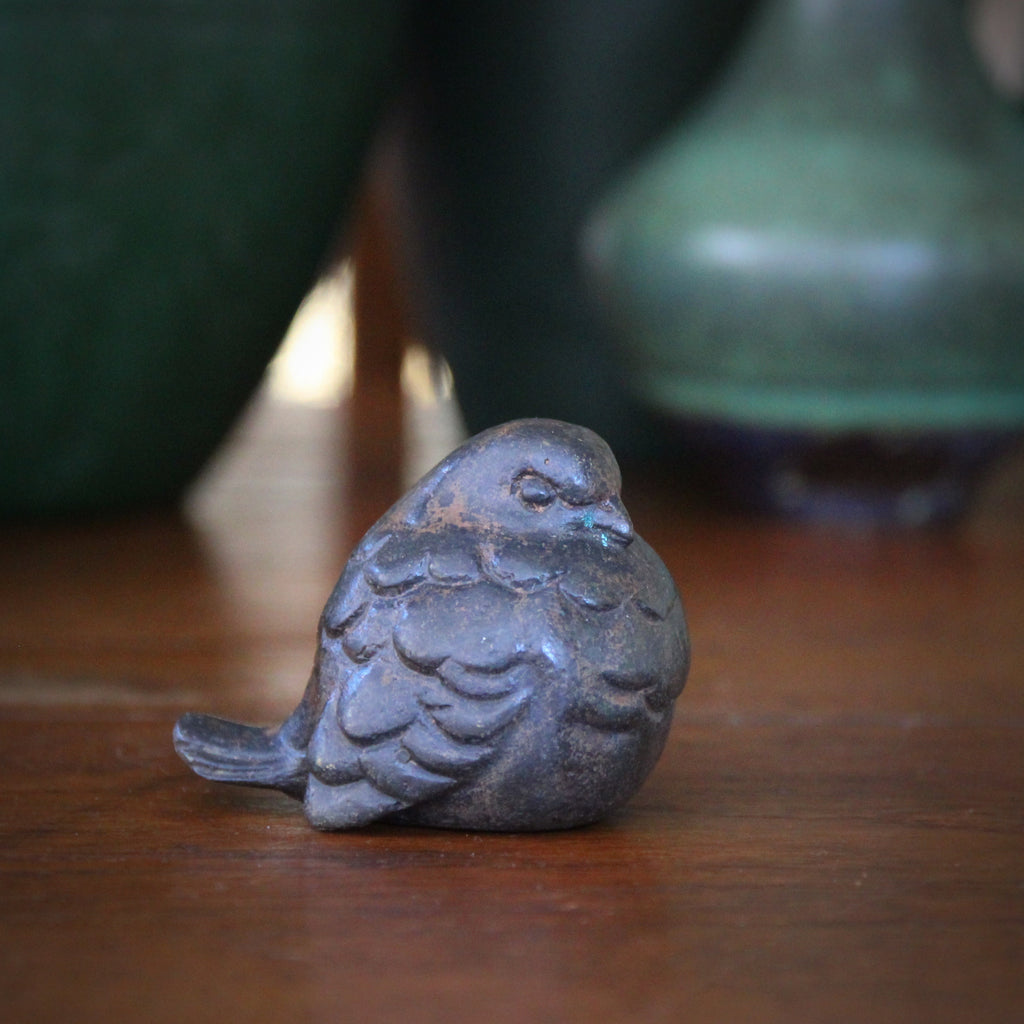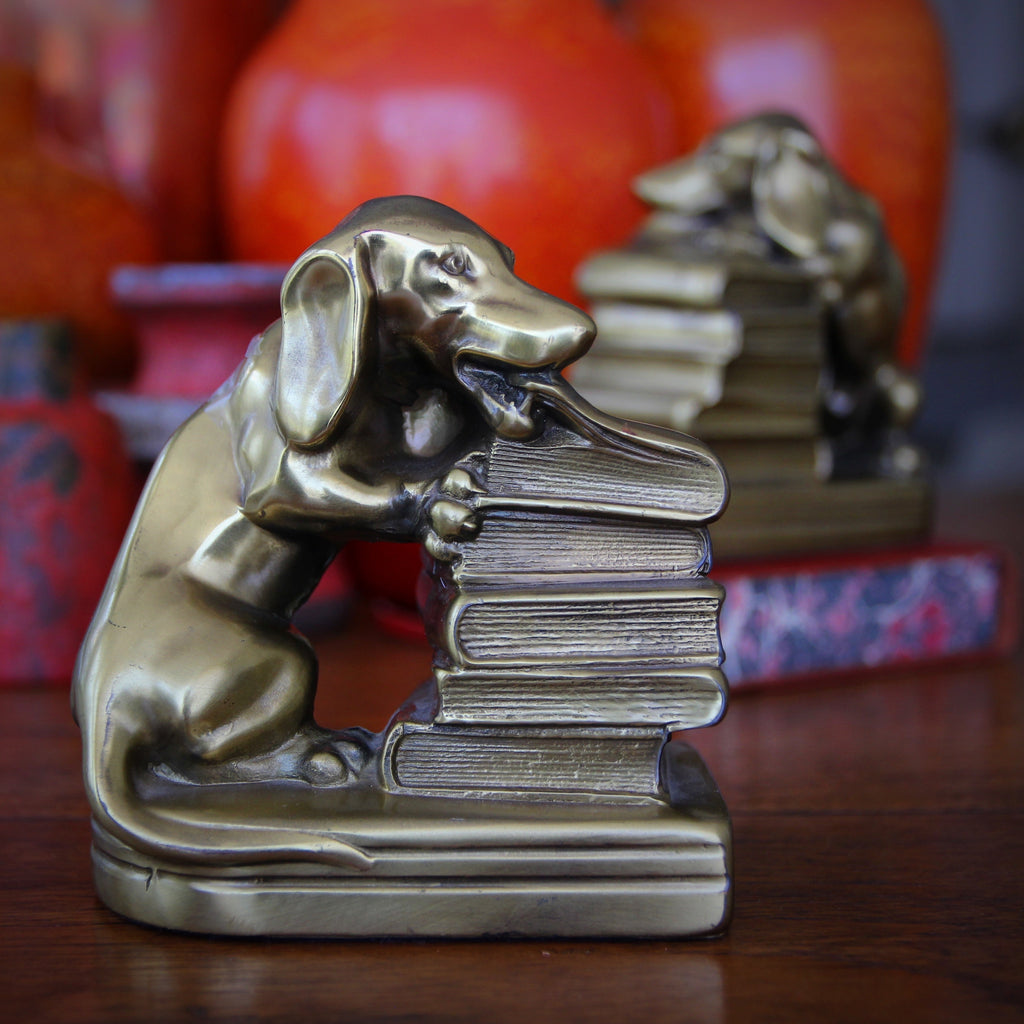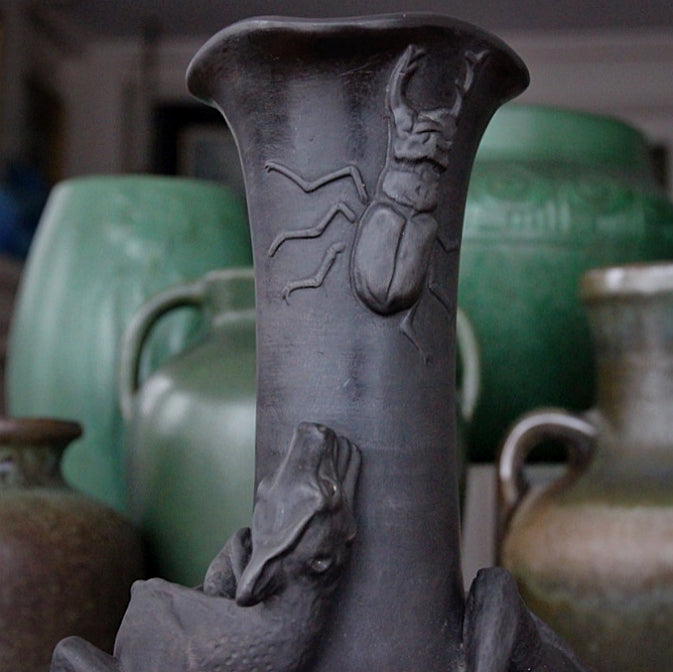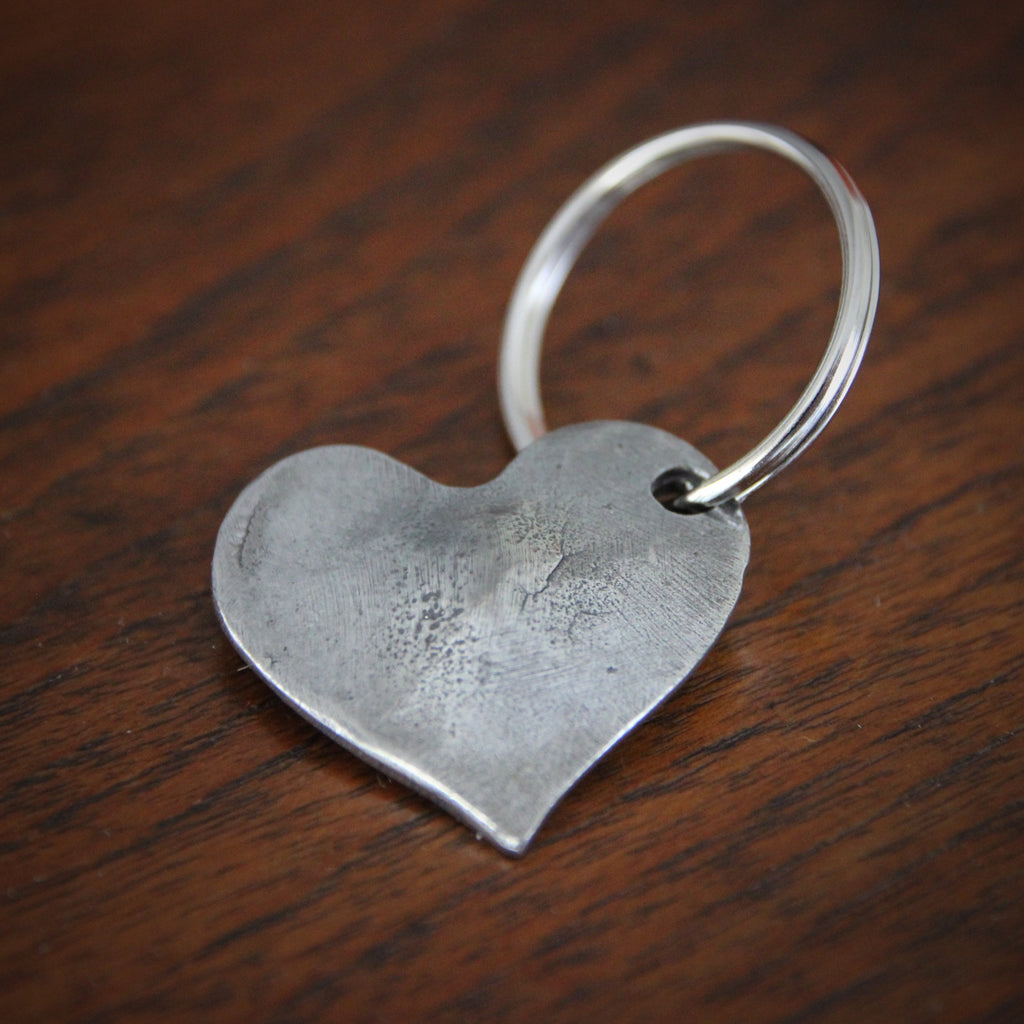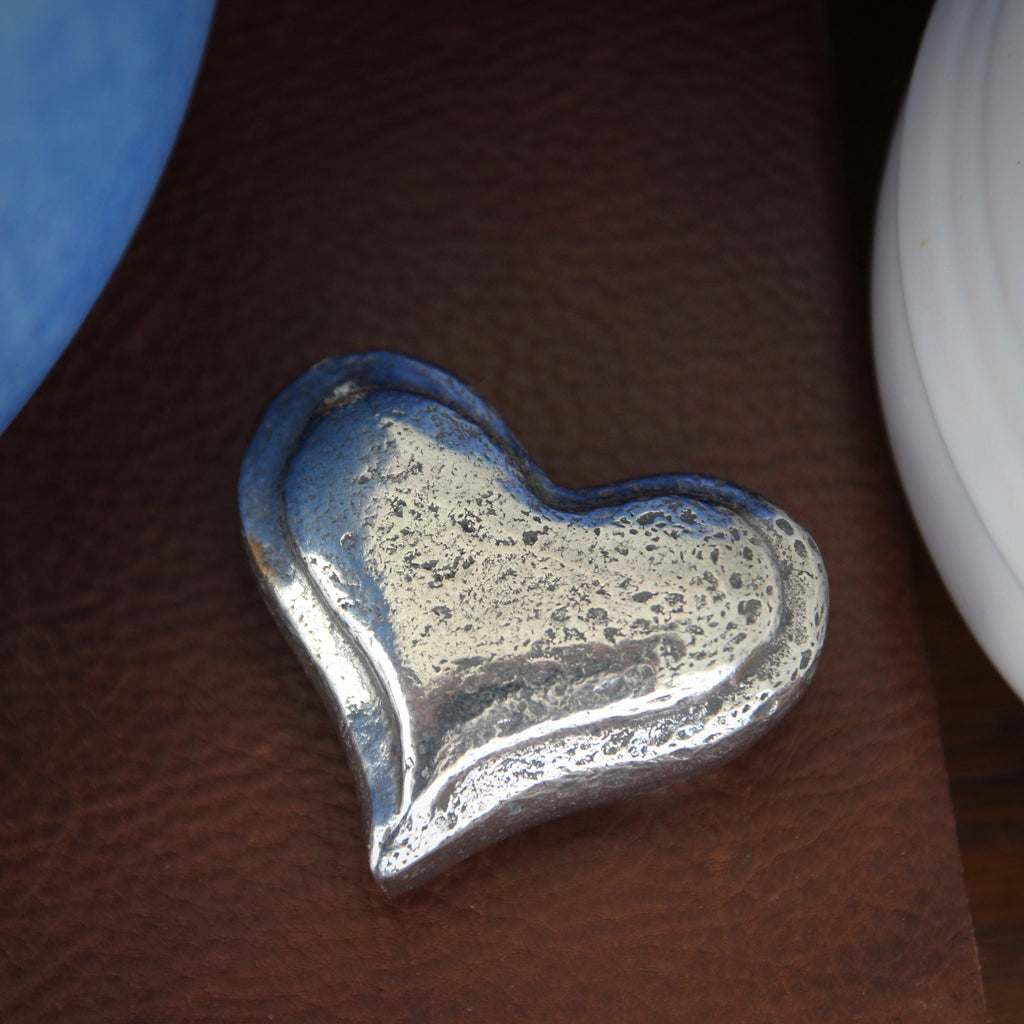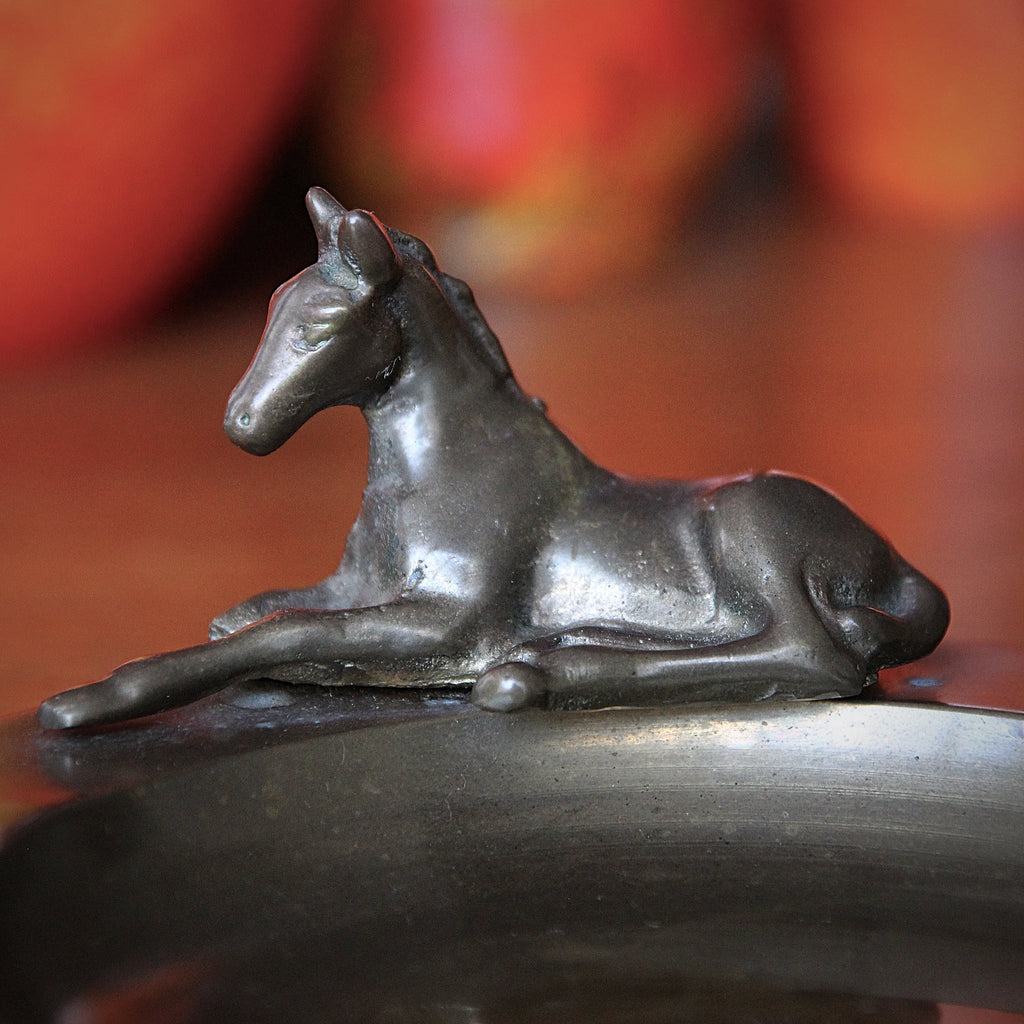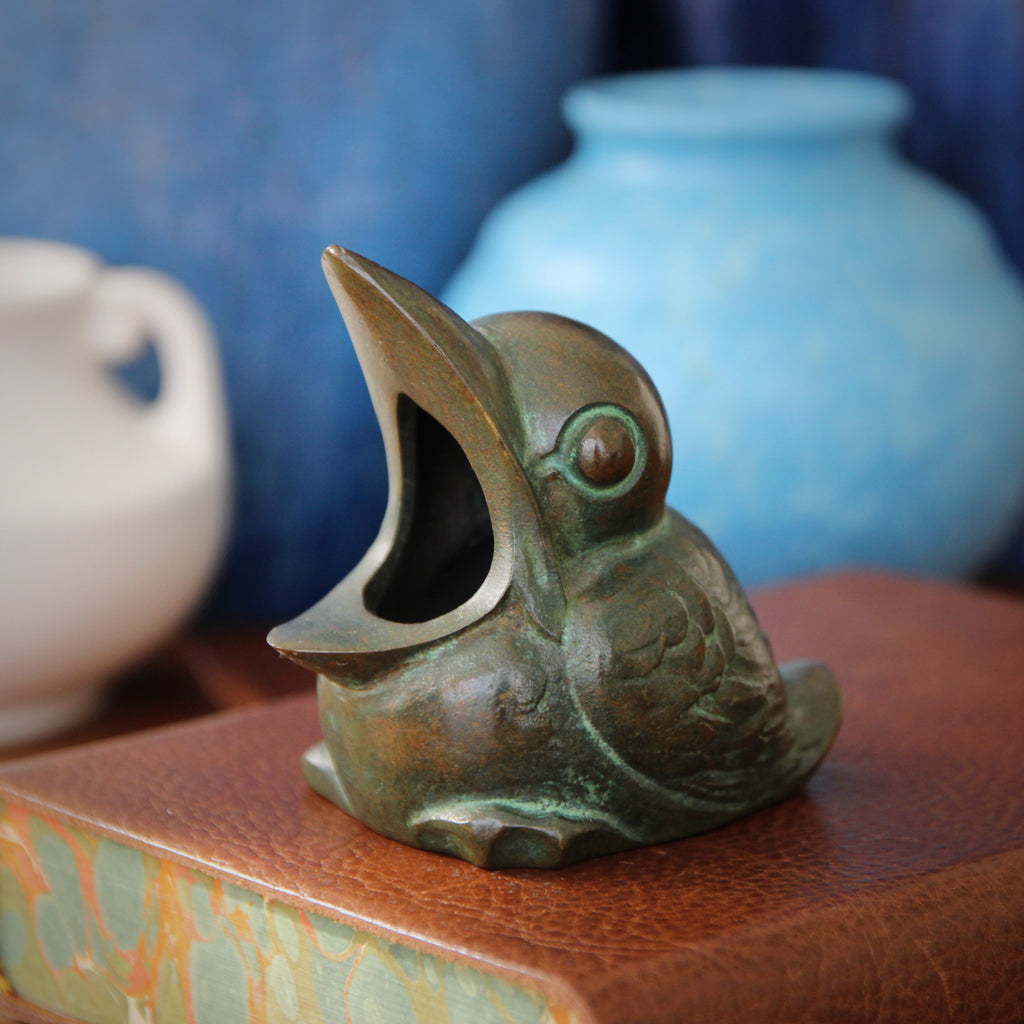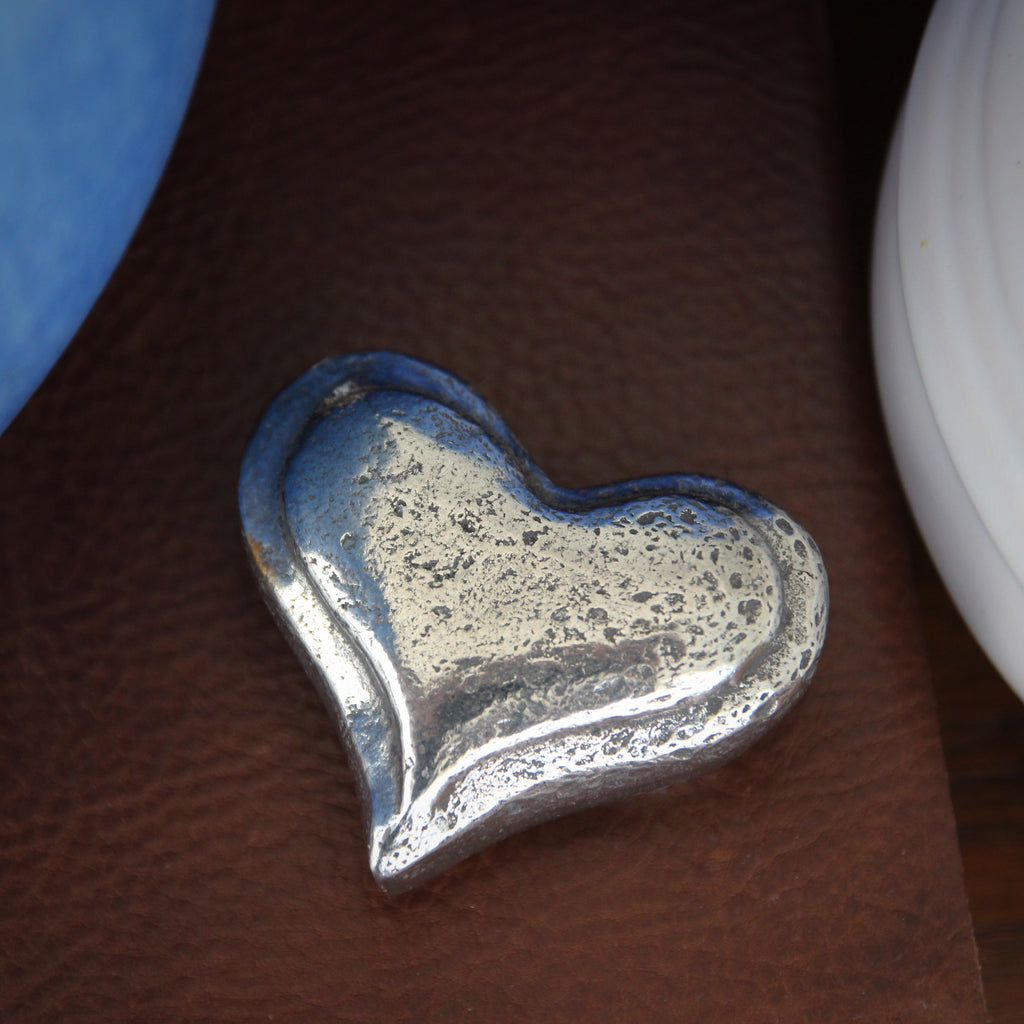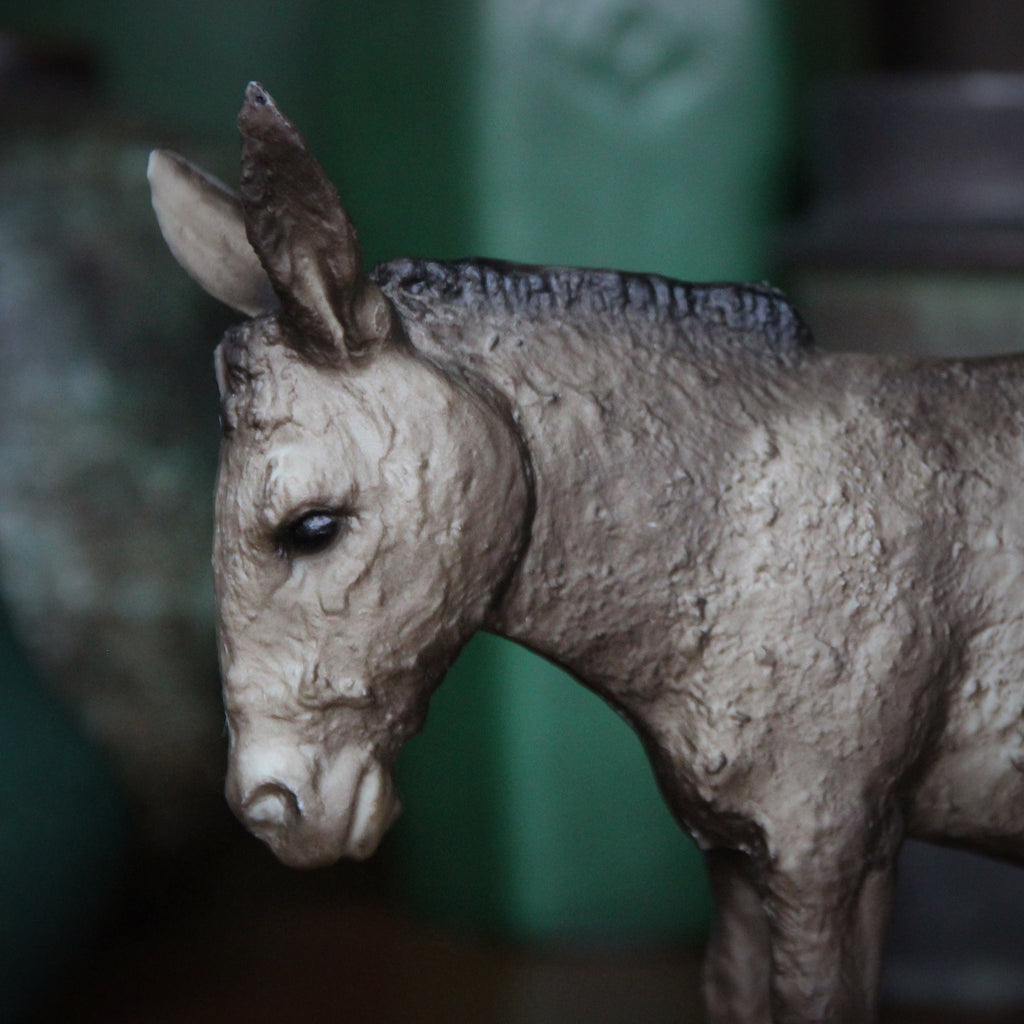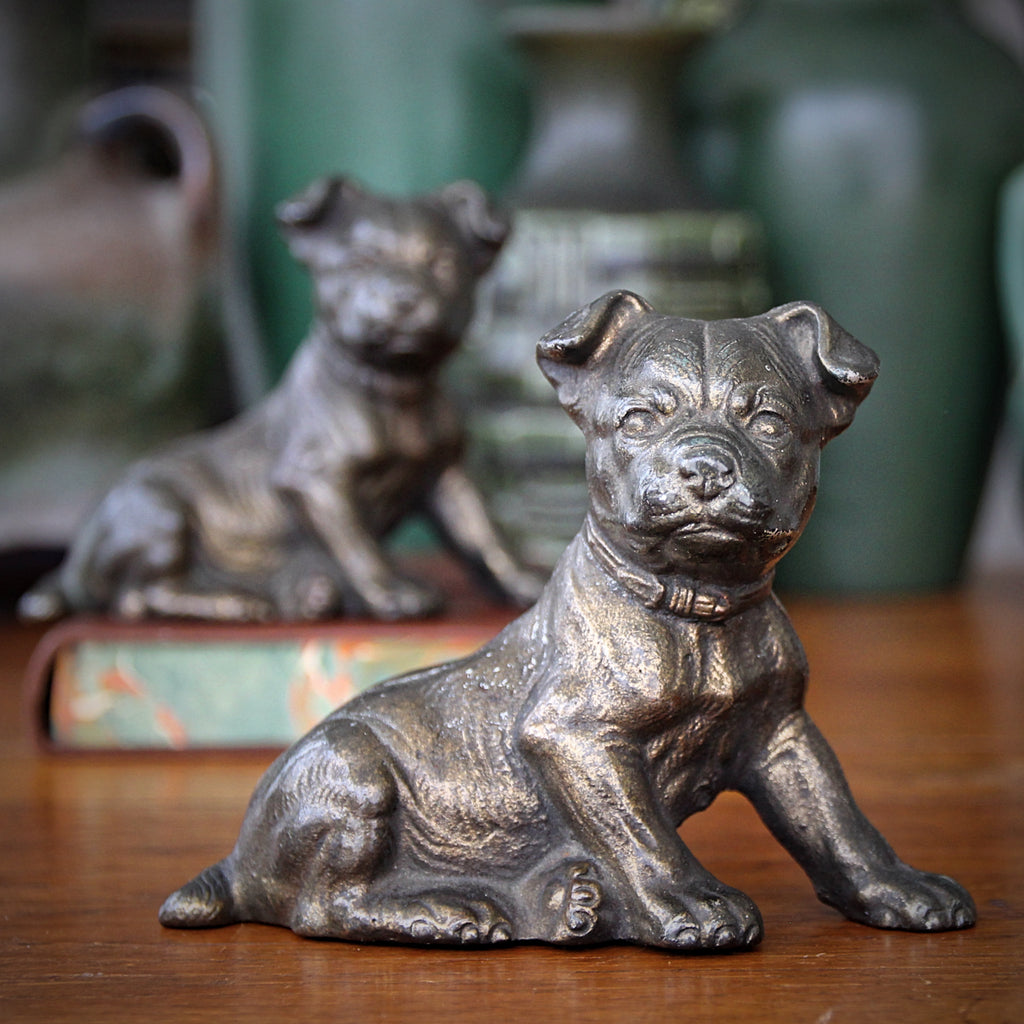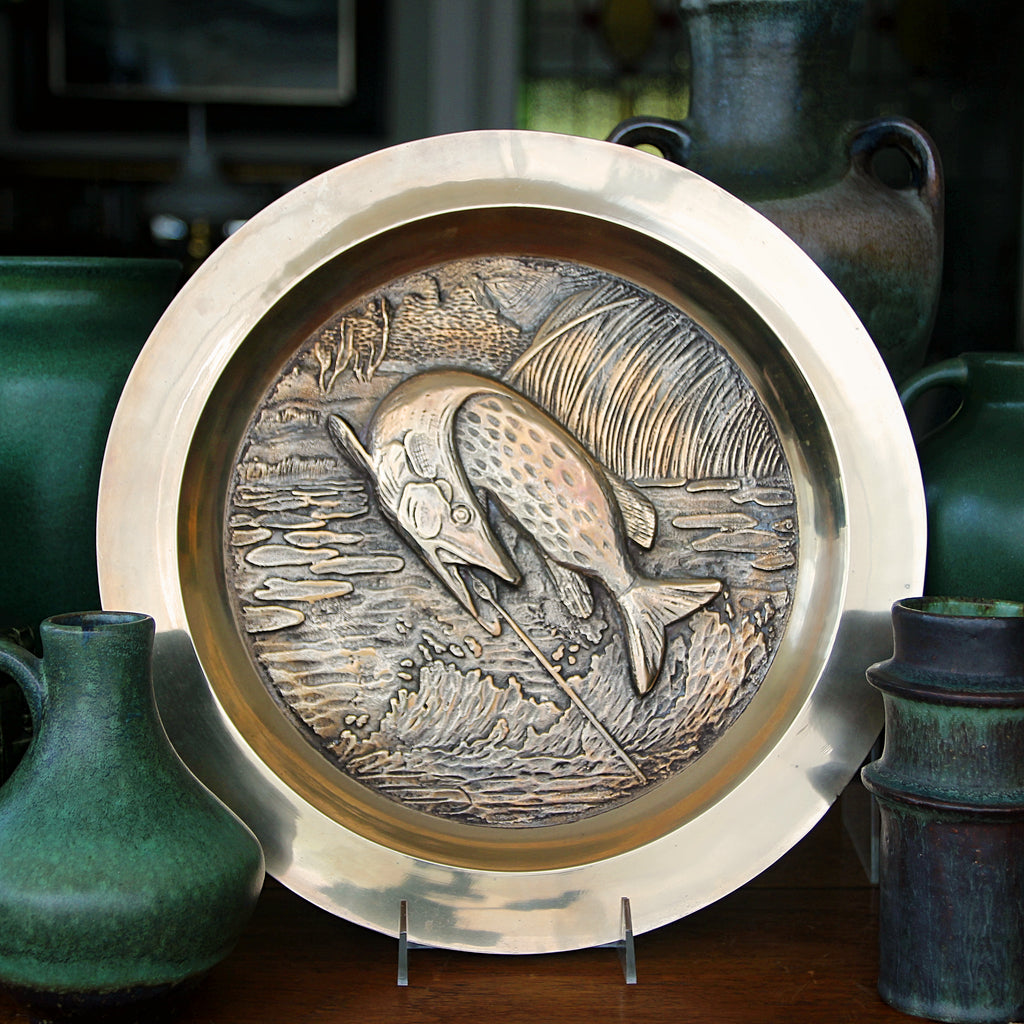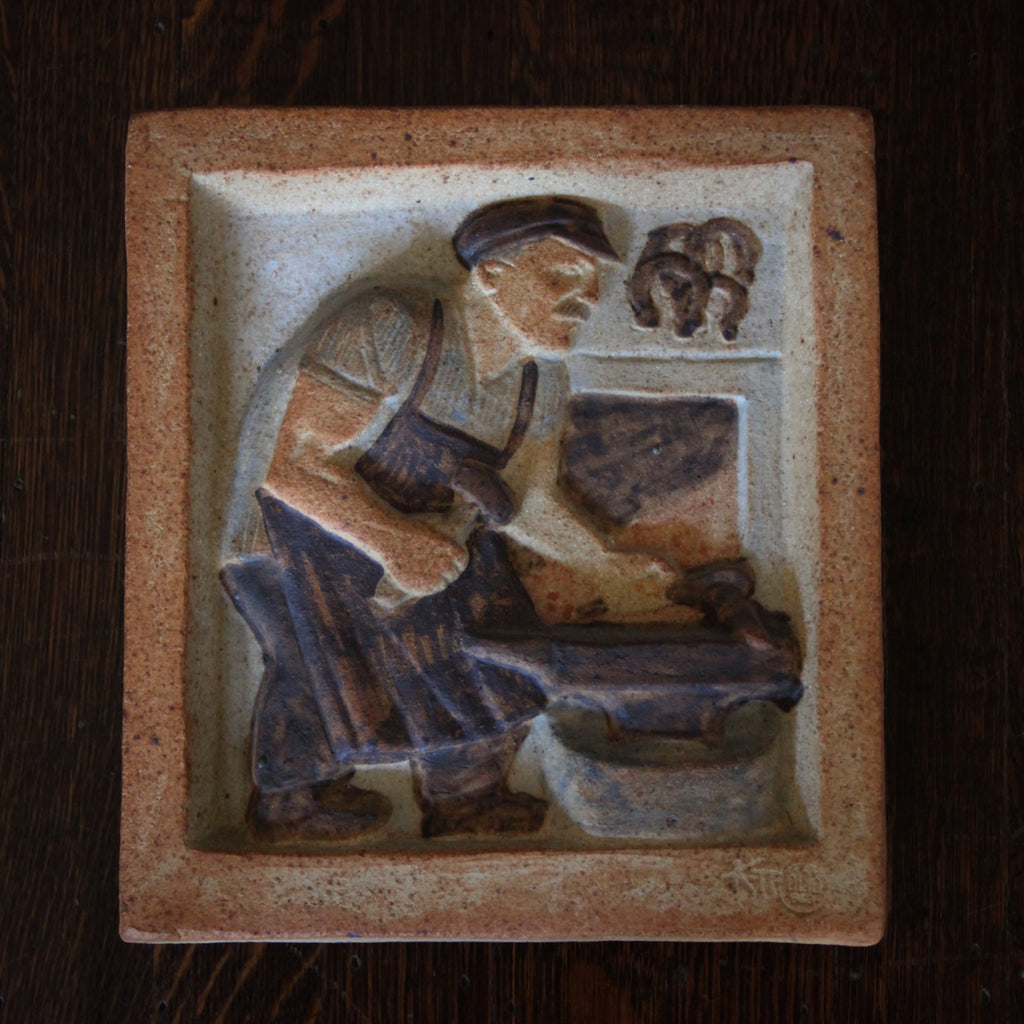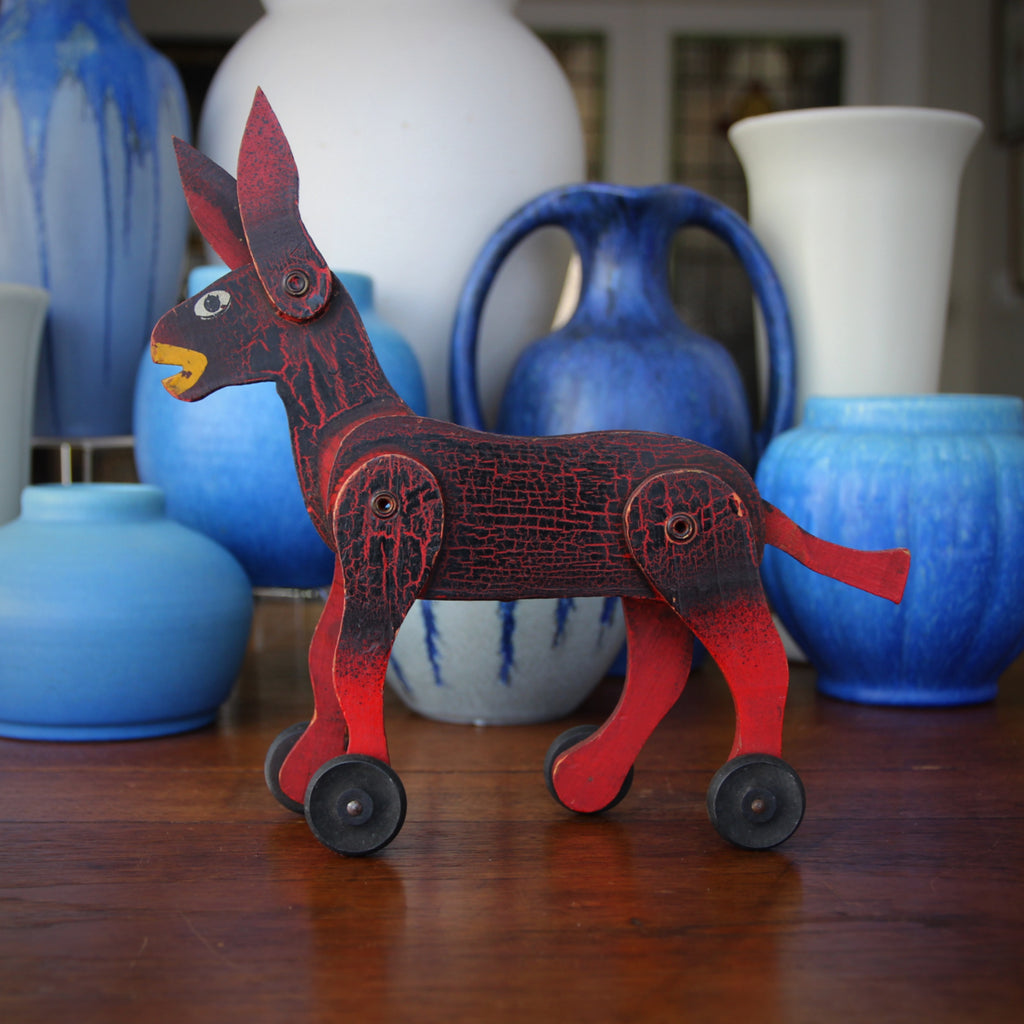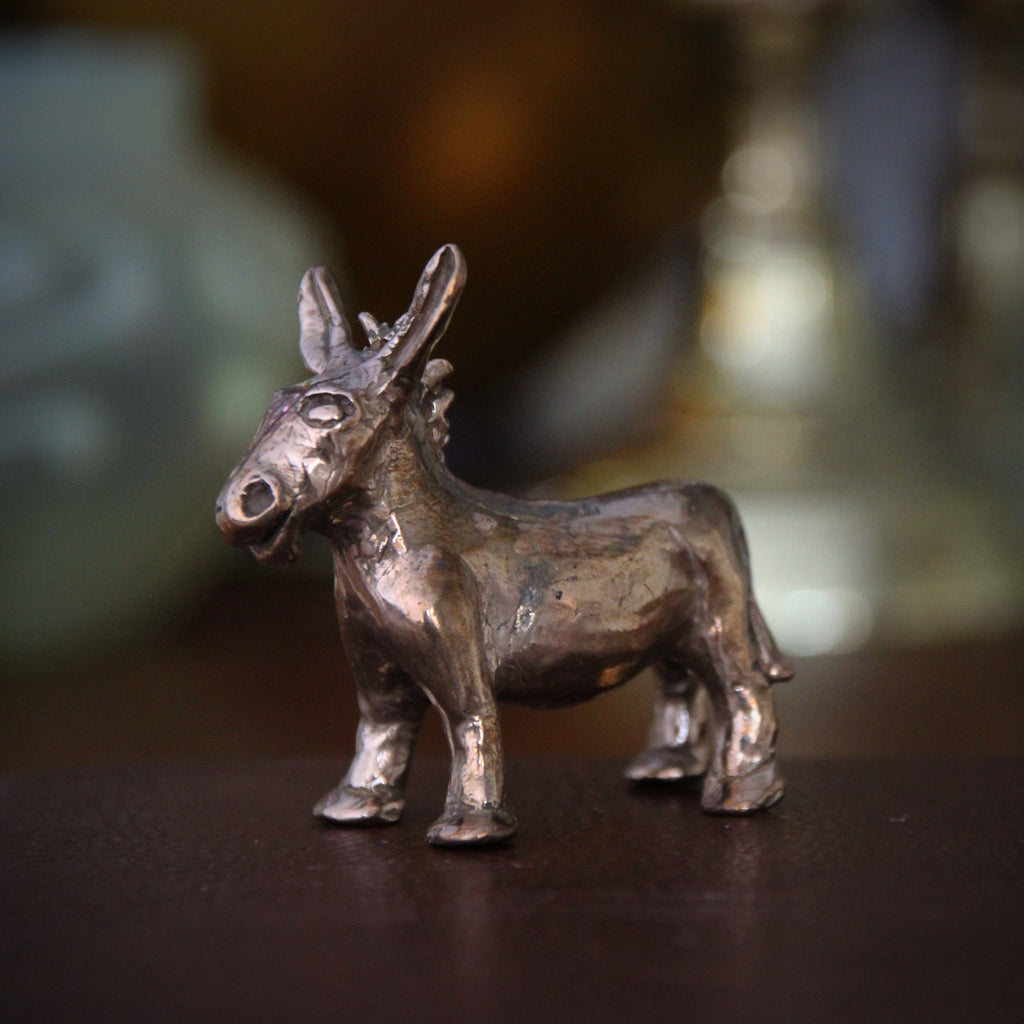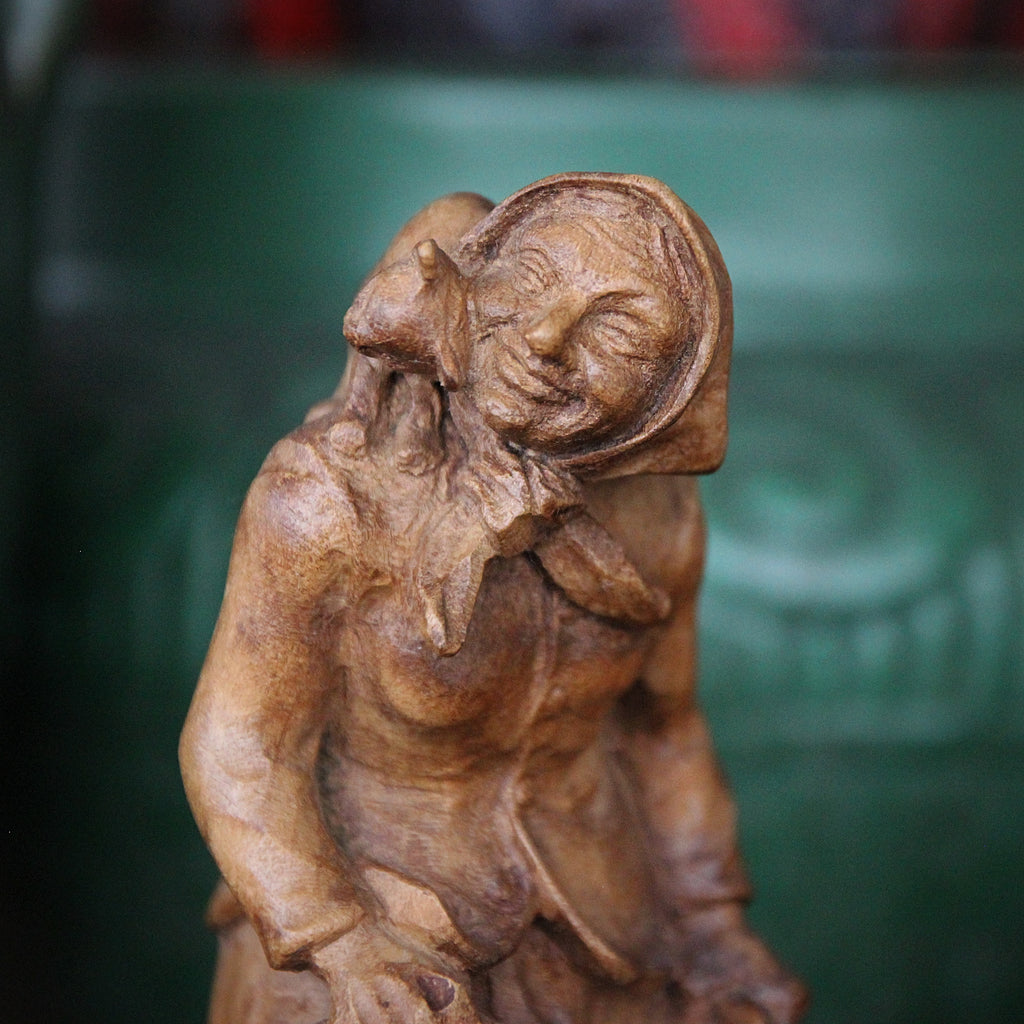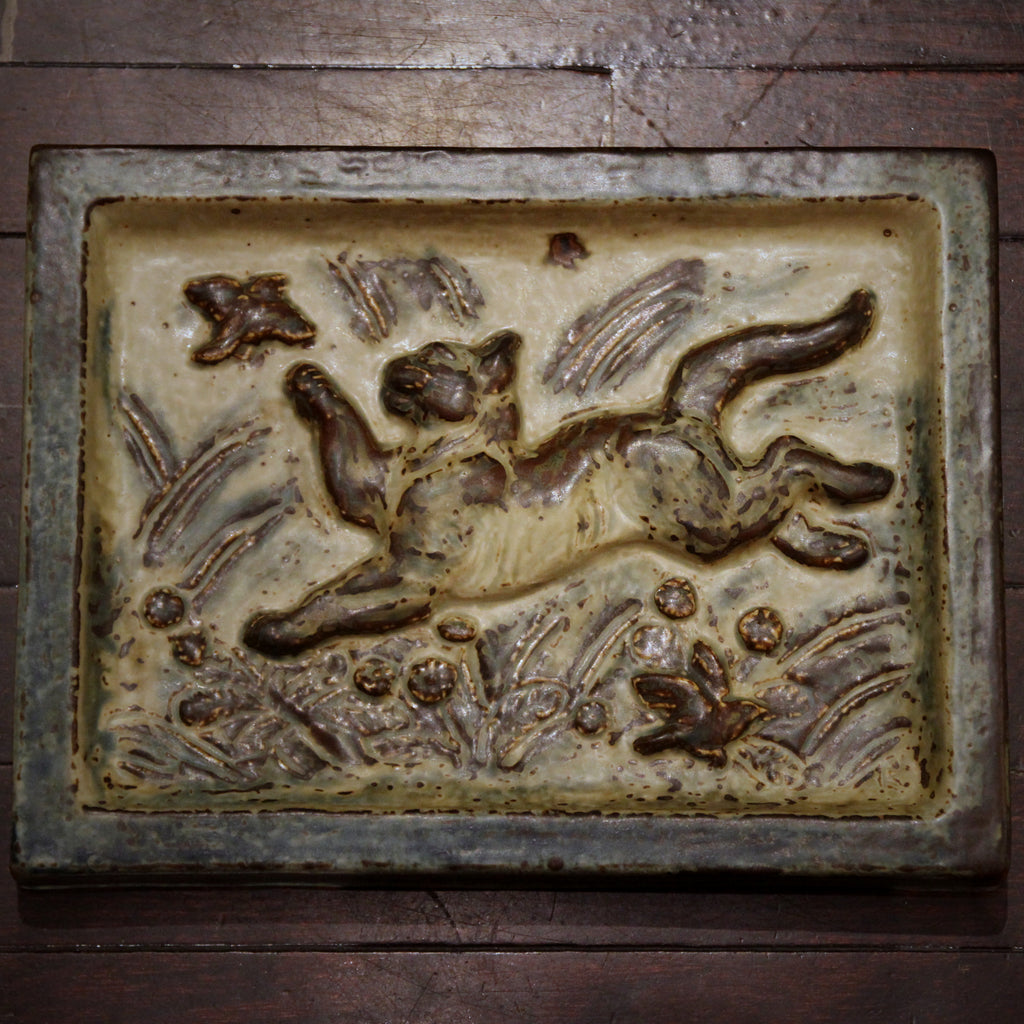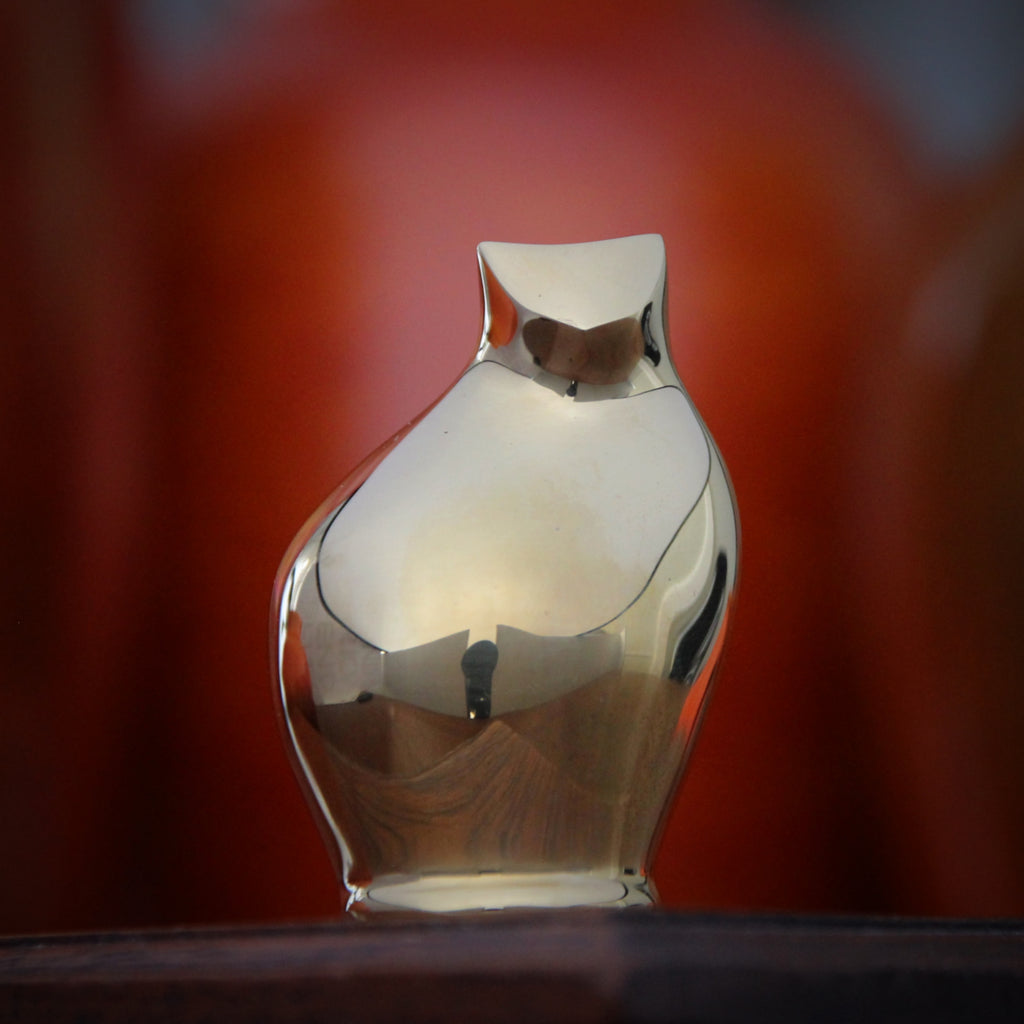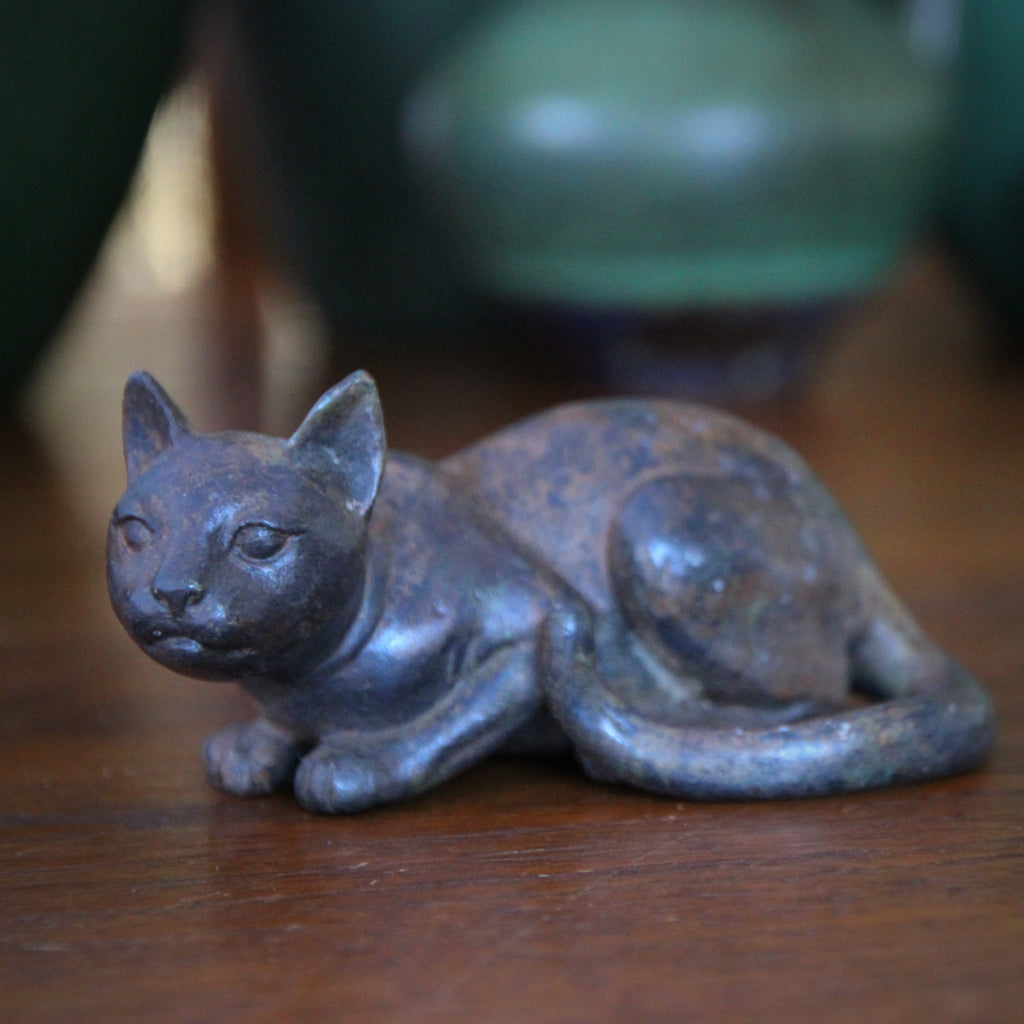JOURNAL — Sculpture RSS
Let's end our week of "bearing-up" with this whimsical piece by Knud Kyhn for Royal Copenhagen. Most of the sculptor's work was highly-naturalistic, shunning cute displays of anthropomorphism. This Danish Modernist piece seems to be one of Kyhn's few pieces which incorporates a bit of fanciful playfulness. A mother bear, while rolling on her back, lifts her cub aloft. It captures a tender moment of bonding between mother and offspring. And it captures the ursine energy of the pair (not to mention the cub's frantic wriggling). The piece, heavy and large, is dated 1957 and is finished in the classic Sung Glaze by Patrick Nordström. It would make a wonderful gift for a new mother. Or a cherished gift from...
Bearing with It - Four
It's only Day Ten of the New Year. And the wild developments just keep-a-coming! As we "bear" with this New World Disorder, we are sharing some of our favorite bears, all currently in-stock at LEO Design. Knud Kyhn's sculptures of wild animals are highly naturalistic. He doesn't sculpted "cutesy creatures" or dabble in much anthropomorphism. His animal sculptures display a realistic, simple and confident Modernism. The sculpted grouping, shown above, depicts a tense scene—far more dramatic than most of Knud Kyhn's renderings. An agitated bear—alarmed by a snake, coiled and ready-to-strike—exerts a Mannerist twist, straining to face the threat. With simple, spontaneous and (somewhat) Impressionistic sculpting, Knud Kyhn was able to imbue this work with a great deal of action...
Bearing with It - Three
Here is another bear sculpted by our Danish friend, Knud Kyhn (1880-1969). This large, heavy and compactly-modeled form catches the startled expression and ursine energy of a lumbering bear. Is she just sitting down? Or trying to get-up?
Knud Kyhn often glazed his pieces in Royal Copenhagen's "Sung Glaze." This dripping blend of colors—browns, creams, blues, greens and oranges—has an earthy, organic and highly-variable appearance. The glaze was developed by Patrick Nordström, a brilliant ceramicist, who distinguished himself through his mastery of complex glazes. His Sung Glaze was inspired by earlier Chinese glazes—which had been intriguing the Western world for centuries.
Bearing with It - Two
Bronze is such a nice metal. There was even a period called the Bronze Age. While bronze was initially developed for making tools and weapons, it was also a wonderful medium in the hands of artists. Sculpture, furniture, lighting and other home furnishings have been (and still are are) made of bronze.
Shown above, a chubby little "shelf-sitter" teddy bear. He is impressionistically modeled, cast in bronze and finished with a dark patina. His little legs were designed to allow him to sit on the edge of a shelf—legs-a-dangling. Place him within view and he'll keep you company at your desk or reading chair.
Bearing with It - One
So much going on! And the year's only a week old! As for me, I'm bearing with it as best I'm able. So let's bear it together! This week we present a selection of handsome bears, all currently in-stock at LEO Design. Knud Khyn was a Danish artist born in 1880. He worked in various media, although, the lion's share of his work was creating stoneware sculpture—and most of his career was working for Royal Copenhagen (during the Art Nouveau, Art Deco and Danish Modernist periods). As one of Royal Copenhagen's premier artists, Khyn designed numerous sculptures in his signature style—mostly wild animals and the occasional mythical creature. Knud Kyhn would sculpt the original models, then supervise their subsequent moulding...
Christmas Eve
Christmas Eve was always a special night in the LEO Design shop in Greenwich Village. We always stayed open until 10:00 pm. Most of the day's Holiday Hustle already had died down by 7:00 pm.. And the customers who did come in—usually after dinner—were in a good mood and, often, feeling little pain. They were relaxed because they were staying in the city for Christmas. Nowhere to go but home! These customers might find a gift for someone they were seeing at New Years or, better yet, something nice for themselves. We used the quiet hours to fill-in merchandise, re-organize as needed, and change the window before Christmas Day. This always meant installing our pair of Italian polychromed terracotta angel...
Happy Hanukkah!
Hanukkah begins tonight at sundown. Wishing all a Happy Festival of Lights! Every great now and then, depending on the idiosyncratic inter-cyclings of the Hebrew (lunar) and Gregorian (solar) calendars, there may be two Hanukkahs in one calendar year. 2025 is such a rarity! Last year's Hanukkah ended on 2 January (2025) and this year's begins on 14 December (2025)—two Hanukkahs in 2025! Even more strange (and more rare) is a year in which where there will be no Hanukkah at all. 3031 (more than a thousand years away) will be such a year with no Festival of Lights (although there will be two Hanukkahs in 3032). This has never happened before—at least not in the 16 centuries since...
Thankful.
Happy Thanksgiving! We're thankful for many things: our families, friends, good health, and the rare day when the busyness of commerce comes to a standstill (at least for one day). And we're thankful for the blessings of wonderful customers who continue to support LEO Design. May you have a wonderful, safe and relaxing Thanksgiving. Take stock of that for which you may be grateful. And we look forward to serving you in the next few weeks. Shown above, a sculpture of The Sluggard by Sir Frederic, Lord Leighton (1830-1896). While Leighton is best known for his paintings, he did create three exceptional sculptures during his career (all male nudes). One day while Leighton was painting, his handsome Italian model, Gaetano...
Autumn in New York - Part Ten
Let's end our trip to New York with a potpourri of handsome and wonderful items—all from the collection of the Metropolitan Museum of Art in Manhattan.
Shown above, an impressive young man who looks none of his 1,800 years old. He was carved of Schist in (what is now) Pakistan in the Third Century AD. He is called "The Buddha of the Future." I'm sure he would turn-heads walking down the street today.
Next we have a Late Renaissance Roman bronze sculpture—a double-tailed Siren—created in the last decades of the Sixteenth Century. She probably once stood outdoors and up-high—perhaps on a fountain or over a gate—on the estate of the powerful Colonna family of Rome.
Autumn in New York - Part Nine
Divine Egypt is an exhibit at the Metropolitan Museum of Art. While I love Egyptian history, art and artistry, I find the pantheon of Gods and Pharaohs to be overwhelming—and confusing. There are so many characters to consider—both divine and human—and there are variations and permutations which add further complexity to the list of names. The Divine Egypt exhibit was helpful in that the artistic objects were clustered together according to the individual god or goddess—not chronologically, not by kingdom, and not by some other scholarly theme. In this way, I was able to "sort-out" and mentally compartmentalize the abundant beauty presented before me. At the entrance to the exhibit, we are greeted by a diorite sculpture of the god...
Autumn in New York - Part Eight
We've always loved ceramics at LEO Design—in every form: vessels, plaques, sculpture or architectural elements. Today we'll share a handful of interesting ceramics pieces from around the world—all in the collection of the Metropolitan Museum of Art. Shown above, an Eighteenth Century porcelain lion. He was made around the year 1732 by Johann Gottlieb Kirchner in Meissen, Germany (about 15 miles from Dresden and 60 miles from the Czech border). This lion was part of a series of large porcelain beasts created for the Japanisches Palais in Dresden. The palace was built in 1715 and expanded shortly thereafter to house the Japanese porcelain collection of King Augustus the Strong. (Collecting Asian ceramics was the rage amongst European aristocrats in the...
Autumn in New York - Part Six
Let's end our long tour of the Metropolitan Museum's Greco-Roman galleries with this showstopper: a Roman Third Century highly-carved marble sarcophagus. There are forty human and animal figures carved in high-relief. At center, Dionysos, the God of Wine, sits astride a panther. A satyr and other Bacchic figures surround him.
Flanking Dionysos, are four human representation of the Four Seasons, two on each side of him. Usually, such symbolic representations employ females. In this case, however, the sculptor(s) portrayed male youths. From left to right we have Winter (holding a brace of ducks), Spring (carrying a basket of flowers), Summer (carrying wheat) and Autumn (bearing a cornucopia of fruit).
Autumn in New York - Part Four
The Metropolitan Museum has a wonderful and handsome wing full of Greek and Roman antiquities. The collection is wonderful—as is the presentation. Over the next couple of days, we'd like to share some of the Greco-Roman items which caught our eye in these galleries. Over the millennia, the "idealized" male form—as depicted in Western art and embraced in Western culture—has not changed much. True, there are a couple of "types." There is the lean, athletic body of a youth. And there also is the strong, muscular build of a mature man. These are two (idealized) representations of the same man as he passes through different stages of his life. Ancient sculptures of nude males look much like the idealized male...
Autumn in New York - Part Two
Central Park has been called "the lungs" of New York City. It is also a place of refreshment, regeneration and relaxation. It is surprising how one can feel totally enveloped by nature—and sometimes feel alone—while only minutes from a bustling city of 8.5 million people. This "dose of nature" has a profound civilizing effect upon those who encounter it. Of course, Central Park is a masterpiece of "Man and Nature." The park was highly planned and landscaped. But the genius intent was to create an artistic, naturalistic setting—one which took advantage of the slopes, ravines and boulders—to create the feeling of wilderness. I am always amazed at how many "little, private spaces," numerous nooks and crannies, have been created in...
Home Comfort
The Wrought Iron Range Company was founded in St. Louis, Missouri, in 1881. The company designed and produced top-of-the-line cookstoves, under the brandname "Home Comfort," and they sent their salesmen door-to-door to sell them. Serious customer prospects would be treated to an in-home demonstration. Not only were the stoves well-made, they had thoughtful features and they looked great. They burned wood or coal.
Home Comfort stoves were made of cast iron and wrought iron. Although cast iron is very strong (and much less expensive to produce), it can become brittle—especially under constant heating and cooling. Home Comfort stoves utilized both types of metal to minimize cracking, which sometimes afflicted their competitors' stoves.
Cervantes
On this day in 1547, (it is believed that) Miguel de Cervantes Saavedra was born outside of Madrid, Spain. He would go on to become one of the most-admired writers in the world and his masterpiece, Don Quixote, is foundational to the Western literary canon. Many consider this book the first modern novel and many consider it the world's greatest novel. But much of Cervantes's early life was lived in poverty and obscurity. He and his family often found themselves dodging creditors or the law. Miguel was one of seven children born to a cash-strapped family—a family which some scholars believe were "New Christians" (that is, Spanish or Portuguese Jewish converts to Catholicism). While this heritage may or may not...
William the Cockerel
On this day in 1066, Guillaume le Conquérant set sail from the mouth of the Somme River in France. He was leading a fleet of French ships to England to claim what he believed was his—the English Crown! William would ultimately kill his competitor at The Battle of Hastings, namely, Harold Godwinson (who also believed that the crown rightfully was his). This profound event ended the Anglo-Saxon reign of England and inaugurated the Norman Conquest (and the "Modern Age" of the English monarchy). This seismic change affected all aspects of English life: the monarchy, government, culture, language and religion. Today's King Charles III is a descendant of William the Conqueror. Before becoming King of England, William had been the Duke...
"And, In This Corner . . . "
On this day in 1960, the first of four televised presidential debates was held in Chicago between Vice President Richard Nixon and Senator John F. Kennedy. It was broadcast nationwide by CBS. Prior to this, presidential debates were never de rigueur. They are not constitutionally-mandated and, certainly, none had ever been televised before. 66 million viewers tuned-in (out of a US population of 179 million). Each candidate was given eight minutes for an opening statement, three minutes for a closing statement, and 2.5 minutes to answer each of the questions posed by the moderator, Howard K. Smith. The focus was on domestic policy issues. Going into the debate, Nixon held a six point lead over Kennedy. He was the sitting...
A Dark Horse
In the world of horserace gambling, a "dark horse" was an unknown or unfamiliar racehorse about which gamblers knew little or nothing with which they could strategize their bets. In the 1830's, the term was expanded to include any kind of competitor—in sports, business or politics—who comes out of nowhere (surprisingly) to win the contest. The ceramic "dark horse" bookends, shown above were made in the 1930's or 1940's by Abingdon in Knoxville, IL. Abingdon was a successful maker of durable, high-end plumbing fixtures: sinks, toilets, water fountains. They used a proprietary blend of quality clays, a dense, "vitreous china" which was highly chip-resistant. Abingdon was known for its fantastic glazes and was the first company to offer products in...
The End of the Trail
Today is the National Trail of Tears Commemoration Day—which marks the day in 1838 when the last of the (surviving) Cherokee Indians completed their forced march from their homeland (in the American Deep South) to the newly-christened "Indian Territory" (now called Oklahoma). As the country's population of European-Americans grew, they began to petition the federal government to clear the Indians from the American Southeast—territory which the white settlers wanted to inhabit. When gold was discovered in Georgia in 1828, the drumbeat intensified. They found an enthusiastic advocate in President Andrew Jackson who pushed-through the Indian Removal Act of 1830, legislation which authorized the federal government to relocate members of the "Five Civilized Tribes" including the Cherokee, Muscogee, Choctaw, Chickasaw and Seminole...
We Choose to Go to the Moon
On this day in 1962—a warm and sunny Texas day—President John F. Kennedy stood before 40,000 spectators in the Rice University Stadium. He laid-out his vision for America's essential leadership in "the space race." "I believe that this nation should commit itself to achieving the goal, before this decade is out, of landing a man on the moon and returning him safely to Earth." He added, "We choose to go to the Moon in this decade and do the other things, not because they are easy, but because they are hard." His goal (and the speech which inaugurated the campaign) was a challenge to Americans to show the world (and themselves) that the U.S. could do great things—for the benefit...
Donkey's Years
Donkeys—about 40 million of them worldwide, divided amongst some 185 varieties—all originate from the African Wild Ass (Equus asinus asinus). For centuries, the word "Ass" was the universal name for the creature (even in the Bible). Males were called "Jacks" or "Jackasses." Females were called a "She-Ass." But, starting in the Eighteenth Century, the name became viewed as, shall we say, impolite? (It was the same time that "cocks" became "roosters" and "coneys" became "rabbits.") "Donkey" has become the most popular (English) name, to this day.
Pin-the-Tail-on-the-Donkey
On several occasions, while traveling, I have been offered a donkey ride, up a steep hill (for a fee), which I have declined on principle. I can't bear the thought of making this poor little creature's life any more difficult than it already is. Besides, a brisk climb up a steep hill is great exercise for me—and it makes the ultimate view that much the sweeter. In England, donkey rides are a popular beach-time attraction. The British Equine Society instructs that donkeys should never be made to carry a rider over 50 kilos (110 pounds). Donkeys should be given a one hour break at lunchtime (or in the early evening). And donkeys must be afforded one day off per week....
Donkey Work
Donkeys have done so much for mankind and, yet, they are frequently overworked, abused and neglected—even as they continue to labor for us. They are the original "beasts of burden." Donkeys are among the earliest domesticated large animals. There is evidence of their living alongside mankind up to 7,000 years ago in Africa (from where they originate). They are depicted in Egyptian tomb paintings—and their skeletal remains have been found buried within those tombs. They originated in East Africa and spread throughout the world—over millennia of human conquest, immigration and trading. Today there are about 185 genetic varieties of donkeys. 96% of the world's donkeys are in underdeveloped countries.
Antonio Canova and His Lion
Let's say farewell to August with this handsome and impressive lion, modeled after The Vigilant Lion sculpted by Antonio Canova in the late Eighteenth Century. Antonio Canova (1757-1822) grew-up with marble dust in his veins. He was sculpting as a very young boy. He was born in Possagno, Italy (outside of Venice), and lost his father (who was a stonecutter) when he was four years old. He was taken-in by his grandfather, a stonemason and owner of a quarry. Canova's grandfather sculpted marble altars in the Late Baroque style. By the age of nine, young Canova was modeling clay and carving marble. At 12, Canova began a two year apprenticeship under Giuseppe Bernardi. He then worked under Giovanni Ferrari before...
Bird Watching - VII
Let's end our week of birds with this graceful bronze swan. She will glide endlessly across your desk or windowsill—a reminder that elegance is often accompanied by tremendous strength and determination.
Bird Watching - VI
Built for speed, the peregrine falcon is the fastest animal on Earth, having been clocked diving at 240 miles per hour. They have been long admired by humans—sometimes worshipped as a god (as the Egyptians did) or domesticated and trained as treasured hunting and sporting companions (in the Arab Middle East). I recall an incident in 2017 in which a Saudi prince purchased 80 airplane seats for his 80 falcons. I have even heard that some falcons have passports, which allows them to travel across international borders with their keepers. Peregrines are found all over the world except in extreme polar regions, in very high mountains, or in tropical rainforests. They even have been known to live in cities which...
Bird Watching - V
Every delicate detail of this pair of sparrows has been captured by the sculptor—feathers, eyes, even the quizzical cock of the head. They are cast in brass then finished with a verdigris bronze patina. The pair would love to spend their winters indoors, with you—on a shelf, mantelpiece or windowsill—though they could endure a life outdoors (where they will age in the weather).
Bird Watching - IV
As Summer comes to an end—and the winter chill sets-in—the birds scurry about, preparing to hunker down in the snow or fly away South. We're sharing some of our favorite birds with you this week, all currently in-stock at LEO Design.
Two nest eggs shine from within their bronze nest—a textured "bowl" which is useful for so many other things. The juxtaposition of shiny bronze against rustic bronze gives great character to this piece.
Bird Watching - II
Nils Thorsson (1898-1975) was a Swedish-born ceramicist who worked for—and greatly influenced—the Royal Copenhagen ceramics workshops, especially during the Modernist boom following World War II. Royal Copenhagen was founded in 1775 and had already reinvented itself several times in the past. However, to position Royal Copenhagen for success after the War, Thorsson recruited to his Aluminia Fajance division (in 1958) a group of six young women—Scandinavian ceramics designers from Norway, Sweden and Denmark. One of these women was Beth Breyen. She was Norwegian and a student from the National Craft and Art Industry School in Oslo (1956-1960). Nils Thorsson worked with Beth (and the other women) to develop the Tenera line. He allowed each designer to see where her inspiration...
Bird Watching - I
At this time of year—late in the summer, heading towards autumn—I see the birds busily scurrying-about, preparing for the winter chill to come. I imagine that they are eating as much as they can, preparing for a long flight south (or a cold hunkering-down here in Pennsylvania). Over the next several days, we'll be sharing som of our favorite birds, now in-stock at LEO Design. This little fellow, round as a ball, seems to be well-prepared for the coming season. Perhaps he is too well prepared? Can he still even fly? His fluffed-up feathers suggest that he's preserving heat—or that he's a little miffed, at what we will never be sure. He's made of cast brass, finished with a verdigris...
The Dog Days of August - I
We're marking the last few days of The Dog Days of Summer (which ends today) with a sampling of our collection of handsome dogs—all currently in-stock at LEO Design.
Here is another charming pair of canine bookends. These were made in the Seventies by "Philadelphia Manufacturing Craftsman." The company was founded by the Startzman family in 1911. Initially, they fabricated metal parts for other manufacturers. In the Fifties, they added "slush-metal" bookends to their production, using old moulds which they had purchased from other bookend makers and some of their original designs. In the Seventies, they moved to Florida and continued to produce bookends.
The Dog Days of August - III
This quirky little pet brings with him a touch of whimsical charm. Charismatically sculpted and cast in polished bronze, his feet reveal a little secret: the letters L-I-F-E imprinted on the bottom of each paw. "Dog's Life." The phrase was coined in the 1500's to refer to an unhappy and miserable existence—such was the lot of dogs at the time. Today, however, most dogs have a rather charmed existence—at least my pup, Benji, does. I wish for the day when all dogs (and cats and birds) can enjoy such a wonderful dog's life.
The Dog Days of August - IV
The "Dog Days of Summer" are upon us. This year, they occur from 3 July through 11 August. As we count-down the last four days of the season, we'd like to share some of our favorite canines, now in-stock at LEO Design. Sirius—called "The Dog Star"—is the brightest star in the sky. Astronomers have noted and tracked it for thousands of years. They charted its annual appearance and movement through the skies and, eventually, began to anticipate when it should return . Dies Caniculares ("The Dog Days") begins when Sirius makes its first appearance on the horizon at dawn (this year, 3 July). By coincidence, this is the hottest time of the year (in the Northern Hemisphere). Ancient Greeks and Romans...
Countdown to LEO - 1
This handsome—and slightly startled— LEO seems to be saying, "Are you talking to me?" The sculptor created a bronze sculpture with character and personality—not the standard, stalwart lion. Nevertheless, this LEO remains regal, despite his quizzical mien.
Countdown to LEO - 3
Most lions featured in art and culture focus on the males—regal specimens with lithe, muscled bodies and glorious manes. Yet, 75% (or more) of adult lions in the wild are female! Certainly, we should give the lady lions a little more attention. Especially since the lionesses do most of the hunting and raising of the young. But, regrettably, this gender imbalance amongst lions highlights the tragic fate most of their males face: a gauntlet of life-or-death challenges under the constant spectre of Darwin's "Survival of the Fittest." These "Leonine Social Dynamics" illustrate a grim picture of the raw, unforgiving "Law of the Jungle." Lions are organized within tight, durable family groups called prides. There is one dominant male, a few...
Countdown to LEO - 4
From the point-of-view of the lion, the story of Young Hercules and the Lion is rather chilling. But it is a classic and bears repeating. In Greek mythology, the Young Hercules—before he became the superhero we know today—was assigned Twelve Labors by his uncle, King Eurystheus of Tiryns. Hercules was being challenged as penance for having killed his family after the goddess, Hera, drove Hercules mad. (She was trying to get back at Hercules's father, Zeus.) The Labors were intended to be impossible for the Young Hercules to accomplish. Hercules's First Labor was to kill the Nemean Lion. Nemea was a village about 20 miles southwest of Corinth. The fearsome Nemean Lion was invincible due to its beautiful golden fur,...
Gregory Seymour Allen, Sculptor
In less than a month's time, the Sun will be passing through LEO. I suppose I could wait to present these bookends, but I'd rather share these beauties now! These bookends were modeled by American sculptor Gregory Seymour Allen (1884-1934). He was born in Orange, New Jersey, and worked in New York City before moving west to Glendale, California. He is known, primarily, as a sculptor of "historical" themes—usually famous personages—in politics, history or the military. He designed plaques, medallions, medals, and the occasional pair of handsome bookends (or other desktop accessories). Allen often sculpted in the bas relief style, including this pair of regal lions. Allen was also a talented Impressionist painter, mostly having painted California landscapes. These handsome...
Art Nouveau, Creepy & Crawly
The Art Nouveau Movement—which we translate as "The New Style" or "The Modern Style"—came on the heels of the Nineteenth Century's "Great Leap Forward." It was a time of progress and increased understanding of science, discovery and critical understanding. At the Turn-of-the-Twentieth-Century, industry boomed. The Middle Class grew. And more people (for the first time) had a little extra money to spend on luxuries, rather than spend every last penny on necessities. This expansion of wealth and markets had an enormous effect on artists, designers, and those who employed them to create and produce merchandise for a growing Middle Class. Whereas, in the past, artists were "commissioned" to work for the "very few, very rich" patrons, artists were now...
Waterloo!
Never underestimate the eagerness of the English to remind the French of their biggest battlefield loss to the English (or vice-versa). In this case, The Battle of Waterloo (18 June 1815) remains the permanent reminder of England's military dominance. That battle also marked the end of the Emperor Napoleon and the Napoleonic Wars (1803-1815).
The brass lion sculpture, shown here, was made in England in 1915—a commemorative item at the time of the battle's centenary.
Waterloo, in 1815, was part of the Kingdom of Netherlands. (Today it is part of Belgium.) Two allied armies—one led by England's Duke of Wellington, the other led by Prussia's Field Marshal Blücher—confronted the French under Napoleon Bonaparte.
Happy Father's Day!
Happy Father's Day to all the men who helped to raise, teach and inspire children—men who provide(d) the best examples of self-discipline, integrity and kindness. Conceiving a child is the easiest step. So is letting someone else raise him or her. Growing a good, constructive and honest child is the hard part (and it is the part that counts). Shown here, a Danish Modernist stoneware sculpture by Axel Thilson Locher (1879 - 1941). He designed works for the Copenhagen ceramics studio Bing & Grøndahl. Locher was born in Copenhagen to an artistic family. His father was nautical painter Carl Ludvig Thilson Locher (1851-1915)—and Carl's father was a nautical painter before him. Both Carl and Axel lived and worked in Skagen,...
Countdown to Father's Day - 1
Nice "things"—Handsome Gifts—do not have to be expensive (though sometimes they are). This bronze bison, sculpted in Canada, is heavy, handsome and full of character. (And he's not too expensive.) Perhaps your dad loves "The Olde West." Maybe he comes from The Old West. Or, maybe he just likes bison.
Which brings-up an interesting question: is there a difference between a bison and a buffalo? Yes there is! A big difference!
The creatures sometimes (inaccurately) called the "American Buffalo" (like the bronze sculpture shown here) are not "buffalo" at all. They are "bison" (scientific name: Bison bison). They were found across the open grasslands of North America.
Countdown to Father's Day - 2
We're sharing some Handsome Gifts ideas for Father's Day. Perhaps you know a much-deserving dad?
For fathers who like to fish, this Korean bronze charger is likely to tick several boxes. The bas relief modeling is superb in its detail, precision, and energy. Grasses at the water's edge, bushes upon the shoreline, even ripples in the water are all portrayed with meticulous detail. And then there's the pike: arched in combat as he struggles to escape. This sculpted bronzework is beautifully rendered and crisply cast—truly the work of a skilled artist.
Countdown to Father's Day - 3
Now: something for the father who appreciates fine and good-looking . . . books. A pair of French terracotta bookends sculpted by Joe Descamps and produced in ceramic by Louis Lourioux. Joe Descamps (1869-1950), sometimes spelled Descomps, was a master sculptor who specialized in female nudes. His subjects were often placed in pastoral or floral settings. He worked in both the Art Nouveau and Art Deco periods (and, indeed, this pair of bookends seems to be "transitional"—that is, reflecting aspects of both aesthetic schools). Descamps also designed jewelry and metal sculpture. Ceramicist Camille Louis Lourioux (1874-1930) was born into a family of potters. In his Twenties, he managed a ceramics workshop with his father. But he soon set-out on his...
Countdown to Father's Day - 4
As we count-down the days to Father's Day, we are sharing some Handsome Gift ideas which might tickle your father's fancy. Some dads like hunting and fishing. Others like tinkering under-the-hood. Some dads cultivate plants. And other dads like to read Shakespearean sonnets and plays.
There are six known signatures of William Shakespeare surviving—signatures written in his own hand. These are found on legal documents such as a court deposition, the purchase of a home, the mortgage on that house, and his Last Will and Testament. No two (of these six) signatures are spelled the same way:
Countdown to Father's Day - 5
Danish artist Knud Kyhn (1880-1969) was a master of capturing "animal energy" in his stoneware sculptures. His bears exhibit ursine energy. His cats express feline energy. And, naturally, his bulls channel bovine energy—as does the "Bull in Repose," shown here. The animal swings its heavy head—atop an impossibly thick neck—perhaps expelling the bothersome flies which have landed on his massive back.
Knud Kyhn worked for Royal Copenhagen for many years, hand-sculpting the original "models" (many of them animals) and supervising their production and glazing. Royal Copenhagen was in the business of producing "collectible" artworks, thus, they would produce a small number of each design every year—usually marking the bottoms of each piece with a date-mark.
Countdown to Father's Day - 6
Father's Day is nigh—and we'd like to share some Handsome Gift ideas for "Dear Ol' Dad." Shown here, a hand-carved wooden bear from the island of Hokkaido, Japan. This northerly island is the most productive region in Japan for farming and fishing. But, during the cold winters (when farmers come-indoors for their seasonal hiatus), the people began carving such bears to keep busy and to provide an additional stream of income. These folk sculptures would be sold to Hokkaido's annual summer tourists—often Japanese visitors escaping the heat and humidity of Souther Japan. Such tourists come to Hokkaido seeking its cooler climes, enjoying its natural beauty, and experiencing the Ainu culture (which once dominated this area). As the bears became more...
LEO - XIV
Today's the Fourteenth day of sharing some of our favorite LEOs—commemorating the new pope, LEO XIV. We end this parade of lions with this simple, yet bold, bronze lion, made in Canada. In the world of heraldry, this LEO would be called a "Lion Statant Guardant Sinister." What this means is that the lion is standing (four feet planted on the ground), head turned (toward the viewer), and facing to the left (instead of facing "dexter," that is to the right, which is conventional). Note that "left" and "right" are oriented from the point-of-view of the soldier holding the shield (upon which such a lion is applied). Thus "left" and "right" are backwards from the viewer's point-of-view. Such "attitudes" are...
LEO - XIII
Cats of any sort—wild cats, house cats—will always be wild-at-heart. Deep within, all cats are hunters. Sighting, stalking, pouncing and (yes) killing are a part of any cat's repertoire. Perhaps it is this fierce, prehistoric impulse which has made lions an inspiration in the arts, literature and other human aspirations.
Shown above, a mountain lion, stalking atop a craggy rock. These cast iron bookends are deftly-sculpted, patinated with a (now well-aged) golden bronze patina and hand-painted with small details. The modeling—especially of the cat—seems to have a rough, "Rodinesque" sensibility, typical of the tastes of the Twenties. The sculptor has captured the desperate energy of a hungry lion.
LEO - XII
The lions portrayed on this pair of cast iron bookends are modeled after Antoine-Louis Barye's 1840 sculpture called "Walking Lion" (which we shared in this journal a few days ago). The bookends were made in the Twenties by Bradley & Hubbard of Meriden, Connecticut. After the original bookend models were sculpted, the pairs were cast in molten iron and finished with a chocolate bronze finish. Bradley & Hubbard was known for its well-finished metal castings. While never at the elite level of a Tiffany or Gorham, Bradley & Hubbard was, nonetheless, very well-respected, making beautifully designed and finished metal objects for America's Middle and Upper-Middle classes. One more significant observation: This pair of bookends was designed with "mirrored" lions—that is,...
LEO - XI
LEO Design is sharing some of our favorite LEOs this week, as we mark the election of the new pontiff, Pope LEO XIV.
Shown here, a Turn-of-the-Century cast iron lion bank. Years of aging has left a darkened and highly-textured surface—while traces of the original golden paint are still visible in the mane. At one time, deposited coins could be removed by unscrewing the two cast iron sides—held-together with a screw. Over the decades, the screw (and two connected halves) seem to have fused-together, making it difficult (or impossible) to open-up. But this handsome vintage lion would easily earn his keep just standing-around, looking good. And think: he was made sometime during the papacy of the last Leo, LEO XIII.
LEO - IX
In honor of the new pope—LEO XIV—we are sharing some of our favorite felines here at LEO Design. All currently are available right here, on the LEO Design website.
This lion, cast in spelter (sometimes called "white metal"), is "cold-painted" after casting, cooling and chasing (that is, cleaning-off any burrs or irregularities from the casting process). This King of the Jungle expresses a gentle, stately demeanor—seemingly at-peace. He pauses atop a small mound, surveying his kingdom to the horizon.
LEO - VI
For these two weeks, we are commemorating new Pope LEO XIV with a parade of handsome lions, now on sale at LEO Design.
On the tummy of this little bronze lion is the impressed word "Courage." Though small, this brave little lion could be your reminder to remain resolute—or it may be a wonderful admonition to someone you love.
LEO - IV
Parisian Antoine-Louis Barye was the greatest animalier of his time—that is, an artist who sculpts realistic animals. He was born in 1796 and got his start as an apprentice under Napoleon’s goldsmith. In 1816, he was admitted to the Ecole des Beaux Arts where he pursued sculpture—initially honing his talent with medallions and bas relief works. Barye enjoyed spending time sketching animals of the Royal Menagerie in Paris’s Jardin des Plantes—and his sketches have been favorably compared to Delacroix’s. From these sketches, the artist would craft small clay models which he would cast in bronze. Both his sketches and his cast bronzes succeeded in capturing the wild, naturalistic personalities of their subjects. Barye also produced monumental works in addition to the...
LEO - II
In commemoration of the new pope—LEO XIV—we will be spending the next fourteen days sharing some of our favorite, handsome LEOs, currently on-offer on this website. Shown above, a cast iron lion bank from the Turn-of-the-Century. It has a rich, dark patina, acquired over more than a century of standing guard. It makes a wonderful sculpture, though I would hesitate to use it to store my coins. I'd advise against using a screwdriver to unscrew the two halves.
LEO - I
Over the past two-and-a-half weeks, I have been captivated by the solemn grandeur on display as the Catholic Church commemorated and buried its beloved Pope Francis. The subsequent period of discernment and the election of his replacement have been equally riveting—with its timeless ritual, drama and (yes) theatre. As a practicing and devoted Roman Catholic, I was highly interested in (and engaged with) the unfolding process and its outcome. Like most Catholics, I hold personal convictions and preferences of how I'd like my Church to journey-on. (Grazie, Francesco!) I also realize that this 2,000 year old institution does not make many sudden jumps—or move very quickly. In this regard, it's good that (in most things) I usually support...
Spring Green - IV
Reginald Guy Cowan (1884-1957) was born into a family of ceramicists in East Liverpool, Ohio (itself a major center of ceramics production). He studied at the New York State School of Clayworking at Alfred University (in Western New York). After school, he settled in Cleveland where, in 1908, he introduced pottery-making in the public schools. He also began teaching ceramics industry at trade schools and was an instructor at the Art Institute of Cleveland. Eventually, Cowan opened his own pottery workshop, the Cleveland Pottery and Tile Company in Lakewood, Ohio—a "street car suburb" of Cleveland, on Lake Erie. Cowan's architectural tiles, used throughout the Greater Cleveland area, paid the rent. But he also produced a small range of decorative "artware"...
Flying the Nest
On this evening, eight years ago, we moved out of our Chelsea apartment. The truckers had just removed the last box. Our furniture was wrapped and rolling. And our rented mini-van was en route to Pittsburgh--400 miles West. Benji sat in his crate between our seats. Lucky, the parakeet, chirped confusedly from his seat-belted cage in the back. This was a major turning-point in our lives. Had we made the right decision? Tomorrow we would meet those very same movers at our new home, where they would unpack the trucks—and leave us with weeks (months, years?) of unpacking, assembling and arranging.
Horse Sense - VIII
This week we are sharing some of our favorite Horse-themed Bookends at LEO Design. Earlier this week, we shared a pair of black vitreous porcelain horse head bookends made by Abingdon (Knoxville, Illinois). Shown above are a white pair—also made by Abingdon—which are equally stately, equally handsome.
Horse Sense - VI
Sculptor Cyrus E. Dallin (1861-1944) was born in Springville, Utah. As a child, Cyrus played with local Native American children and developed a deep respect for their culture (and a sympathy for their plight). During his fruitful career, he created a cycle of four Native American sculptural groupings (between 1890 and 1908). The fourth of these sculptures, called Appeal to the Great Spirit, inspired the pair of cast iron bookends shown above, made in the Twenties or Thirties. At the age of 19, Dallin left Utah for Boston where he apprenticed under sculptor T.H. Bartlett. In Boston, he befriended sculptor Augustus St. Gaudens and painter John Singer Sargent. In time, Dallin travelled to Paris to study at the Académie Julian....
Horse Sense - IV
The Abingdon Sanitary Manufacturing Company was founded in Knoxville, Illinois in 1908. They made very high quality plumbing fixtures: toilets, sinks, water fountains and other "sanitary ware." Abingdon's products were made of "vitreous porcelain"—a very heavy, dense, porcelain ceramic, coated with glass-like enameling which made the piece durable, impervious to damage or staining, and easy to clean. The company was regarded as the best in the business. They were the first company to introduce colored plumbing fixtures in 1928. And, in 1933, Abingdon provided all the plumbing fixtures for the Chicago World's Fair. Alas, during the Great Depression, the building industry was hard hit. Orders for plumbing fixtures dried-up. So, in 1934, Abingdon began producing decorative consumer goods (with the...
Horse Sense - III
Sculptor James Earle Fraser (1876-1953) was born in Winona, Minnesota. Even as a boy, he was moved by the plight of Native Americans who were being pushed further West or confined to reservations. He studied at the Art Institute of Chicago, followed by studies in Paris, at the École des Beaux Arts and the Académie Julian.
Shown above, a pair of cast iron bookends based on Fraser's famous sculpture, The End of the Trail. His first model was made in 1894, while Fraser was still a teenager. He made several copies, in varying sizes, including one which was displayed at the San Francisco Panama-Pacific International Exposition in 1915. The exhibition helped make the sculpture very famous.
Birds of a Feather - X
Let's end our pre-Spring flight with this little guy—a roly-poly baby bird. He is cast in brass and finished with a verdigris bronze patina. He may not be read to take flight. (He may never be able to take flight!) But he will look ever-so-cute sitting in-place, waiting for that hopeful day.
Birds of a Feather - IX
Like Mary Poppins's talking brolly handle, this pretty parrot is mostly content to stand quietly—waiting to be of use. The cold-painted Victorian bronze tea bell produces a delicate tinkling. It's loud enough to be heard by the servants, but not so brash as to disrupt your restorative respite. And its time-worn patina provides just the right touch of gentle decadence.
Birds of a Feather - VIII
This pair of gentle sparrows—one tail-up, one tail-down—are sculpted with meticulous detail and convey the watchful energy of such a vulnerable creature. They bear a naturalistic, not Impressionistic, resemblance to the real birds and would make a lovely addition to that perfect little spot in your home.
Birds of a Feather - VII
Beth Breyen was one of six young, female designers, recruited by artist Nils Thorsson, to come work for Royal Copenhagen in the post-WW2 era. She was born in Norway and studied art in Oslo (form 1956 to 1960). Thorsson developed the Modernist Tenera line at Royal Copenhagen and allowed his young design staff artists to contribute their own ideas to the various items within the range. Beth Breyen seems to have been inspired by fluffy—perhaps slightly demented—birds. It is a recurring theme in her work. This ceramic plaque, made in the Sixties or Seventies, shows a pair of birds (is it a mother and a chick?) standing against a rich blue background. It was sculpted by Breyen and produced jointly...
Birds of a Feather - VI
Our fluffy little bird—puffed-up against the cold—looks like he's ready for Spring. He's cast in brass, finished with a verdigris bronze patina.
Birds of a Feather - V
Rise and Shine! This brassy British bantam is bellowing with bold abandon! He was cast in Edwardian England, circa 1910. Let him happily greet the dawn from your desk, bookshelf or bedside table.
Birds of a Feather - IV
Swan Lake is my favorite ballet. And this is not because of the storyline or the dancing. It's because of the sublime music by Tchaikovsky. The music is ravishing and poignant and devastating. It goes right to my heart. How could one not be moved (elevated and dashed) by this incredible 1876 score?
This little bronze swan, cast in Canada, will seemingly glide across your desk, bookshelf or windowsill.
Birds of a Feather - III
In times past, children would be found playing with small sculpted figurines—perhaps soldiers, animals or automobiles. Such animals might be those varieties found on a farm, at a circus, in a zoo or on Noah's Ark. Here we have a pair of British tin penguins—dressed in their fancy, hand-painted black and white "tuxedos." They probably originated from a collection of zoo animals in the Twenties or Thirties. Playful penguins have always captivated humans. Their rocking gait, formal "attire" and devoted nesting practices have made them ripe for anthropomorphism. Indeed, these little tin birds have loads of personality—despite the simplicity of their design.
Birds of a Feather - II
The peregrine falcon in the fastest animal on Earth—at times achieving speeds of 240 miles per hour (while dive-bombing prey). Their athleticism, ferocity and trainability have made them useful to humans. Falconers have been working with peregrine falcons for 3,000 years. And the birds' hunting prowess (and noble appearance) have made them an iconic symbol of divinity, royalty and military strength for millennia. The Egyptian Sun god, Ra, was portrayed as a man with a falcon's head.
The Danish Modernist falcon, shown above, was sculpted by Knud Kyhn for Royal Copenhagen. It is dated 1967. It captures the hunter in a moment of watchful rest.
Birds of a Feather - I
Spring is in the air. We've been teased with fleeting moments of warmth—only to be blanketed with snow and ice the next day. But the birds are aflutter, zooming through my backyard. Let's anticipate the Spring with a selection of feathered friends, all now in-stock at LEO Design.
Shown above, a brass tea bell—its handle a chickadee, alighted upon a leafy twig. It's a handsome bell, whether employed at-table, sitting upon a pile of coffee table books, or standing sentry on your windowsill.
St. Valentine's Day
Valentinus was a Third Century Roman priest—possibly a bishop—who ministered to the persecuted Christians of Rome. He was arrested by Roman Emperor, Claudius II, who came to like the charming priest. However, when Valentinus pressed the emperor to become a Christian, Claudius laid-down an ultimatum: either Valentinus would renounce Christ or he would be beaten and beheaded. Valentinus met his martyrdom around the year 270—on the Via Flaminia. His relics were kept in the Church and Catacombs of San Valentino in Rome which became a popular Medieval pilgrimage destination. In the 13th Century, he was moved to Santa Prassede, then to the Basilica of Santa Maria in Cosmedin. More of his relics can be found in Madrid, Dublin, Prague, Lesbos,...
A Lot to Bear
The times . . . well, it's a lot to bear. So let's distract ourselves with a lot of bear. Shown here, an extra large hand-carved bear from Hokkaido, Japan. Hokkaido is the second largest island in Japan, up in the chilly North. Its capital, Sapporo, is known for its namesake beer. The island was once populated by the Ainu people—who lived on Hokkaido, in Southeastern Russia, and on the string of islands which stretched between Japan and Russia. In ancient times, the Ainu maintained a "hunter gatherer" society, even while the rest of Japan developed a farming lifestyle. In time, however, through colonization and forced assimilation, the Ainu people conformed to the Japanese culture, economy and way of life....
Winter White - X
These snowy white horse heads are bookends, nicely-sculpted and cast in highly-durable vitreous china by Abingdon Pottery (Knoxville, Illinois).
The Abingdon Sanitary Manufacturing Company was founded in 1908 and quickly gained a reputation for its beautifully-finished plumbing fixtures, made of ultra-durable vitreous china which was less susceptible to hairline cracking or chipping. In addition to superior (and expensive) clays, the company also spent a great deal of effort hand-finishing each sink, toilet, urinal, water fountain or bottled water dispenser. Abingdon was the first to introduce colored plumbing fixtures (in 1928) and were commissioned to provide all the plumbing fixtures for the Chicago World's Fair in 1933.
Il Condottiero
Bartolomeo Colleoni (1400-1475) was the Captain-General of Venice in the third-quarter of the Fifteenth Century. He was a "Condottiero"—a term which (in Medieval times) meant mercenary leader, but later (in the Renaissance, during which time Colleoni lived) it became an honorific for any great and famous military leader. He was born to a noble family in Solza (near Bergamo, then part of the Duchy of Milan) and trained as a soldier. He spent much of his life serving the Republic of Venice. But he also served various Dukes of Milan—at times Venice's bitter rival.
A great tactician, Colleoni took-back for Venice territories which previously had been stolen from them by Milan.
The Epiphany
For some, January Sixth is a holy day: The Feast of the Epiphany. Theologically, it represents the moment when the Christ Child's divinity was recognized by the greater world (represented in the form of the three foreign Magi). The word, Epiphany, derives from the ancient Koine Greek "epipháneia," meaning "manifestation" or "appearance." The Epiphany is observed by most Christian denominations, though the date may vary based on the calendar system each particular denomination uses. For some Christians, Epiphany celebrations are bigger than those of Christmas. And the name, Epiphany, may be called "Theophany," "Three Kings' Day" or "Little Christmas."
Merry Christmas
Wishing all—customers, friends, family, employees old and new—a Merry Christmas, Happy Hanukkah and a New Year of health and happiness. Thank you for your support of LEO Design this year! I hope our paths cross in 2025.
Christmas Eve
In my first year on Bleecker Street, I purchased a pair of polychromed terracotta candleholders from a workshop in Italy. I knew nothing about them—except that I loved the angels and I loved Italy. Despite their high price, I bit the bullet and purchased them. "Someone," I said to myself, "was sure to like them as much as I do." I have since learned that the male angel, shown above, was based on a sculpture carved by the teenaged Michelangelo for the Arca di San Domenico (The Tomb of Saint Domenic) in Bologna, Italy. He installed the angel candle-bearer in 1494 and was paid 30 ducats for his work. The boy-artist was also commissioned to carve small statues of Saints Procolo...
Playful Pup
How wonderful to wake-up, Christmas Morning, to a playful little puppy waiting under the tree. While I would strongly discourage giving a real puppy as a gift (unless it were properly planned), I do endorse this little silver-plated music box which plays Brahm's Lullaby (published in 1868). Wind him up and enjoy Brahm's most famous tune.
The Winter Solstice
Today—at precisely 4:21 am Eastern Time—the Northern Hemisphere experiences the Winter Solstice. For those of us living above the Equator, 4:21 am is the moment of the year when the Northern Hemisphere will be tilted its farthest distance from the Sun. Today we'll see the shortest amount of daylight of the year, the longest amount of night, and it will be the first day of Winter. (In the Southern Hemisphere, today will be the longest day of the year, the shortest night, and the first day of Summer.) The best news: starting tomorrow, each consecutive day's period of daylight will be increasingly longer and longer.
Winter is Here
After a prolonged and warm Autumn (we used to call it "Indian Summer"), winter finally came—and it descended fast. I've already been (light) shoveling for a week. And we've had consecutive days well-below freezing. If that's not enough winter for you, perhaps these handsome pressed-glass pine trees will bring it home. Two sculpted glass trees—seemingly laden with snow—stand as a pair (one short, one tall). They are beautiful for the Holidays though they would look nice on a windowsill year 'round—catching and diffusing the light that hits them. Click on the photo above to learn more about them. Though our Greenwich Village store is now permanently closed, LEO Design is still alive and well! Please visit our on-line store...
Two Weeks 'til Hanukkah!
It's two weeks until Hanukkah—the Jewish Festival of Lights.
The dates for Hanukkah follow the Hebrew Calendar—beginning on the 25th day of Kislev—and the holiday can fall anywhere from late November to late December on the Gregorian (modern day) Calendar. This year, Hanukkah will begin at sundown on Christmas Day. This coincidence occurs infrequently, most recently in 2005. Before that, Hanukkah coincided with Christmas Day in 1959, 1921, and 1910. The next time that Hanukkah will begin on Christmas Day will be in 2035.
The Hanukkah menorah, shown above, was cast in bronze in the form of a windswept cypress tree.
Giving Thanks
I have spent my adult life as a merchant. Thanksgiving has always been a milestone day in my professional calendar. Despite the busy-ness of the season—the preparation and the crazy days to come—I love this quiet day to rest and reflect on everything for which I am grateful: my friends and family, my health, my customers and my faith.
Shown above, a cast pewter heart. It's a sculpture, a paperweight, a loving memento.
Wishing you a wonderful Thanksgiving Day. And I hope that we might "cross paths" between now and Christmas!
Keeping it Together
Before the Holidays arrive—and sweep us away—we have a few days remaining to activate those long-planned organizational systems, simple or complex as they may be. Having "just the right place" to keep important items can save us time and annoyance (when we most need to be operating efficiently). For me, having my keys and wallet stashed in their proper place makes for a less dramatic morning—when I'm scrambling to get-out-the-door on-time.
This heavy brass "pocket caddy" is the perfect place to keep those pocketable items, perhaps near the door (where they can always be located). This caddy can also be used at bedside—to keep-tidy one's watch, cufflinks, coins, rings or collar stays.
Cute and Cuddly
When I found this charming baby bird, I just couldn't resist. I suppose his plump body, big eyes and open mouth are his evolutionary insurance that his parents will continue to feed and protect him—until such time he can provide those functions for himself. Could this be why we find baby creatures adorable? So that we will continue to nurture them through those vulnerable years? This little Japanese bird—is it meant to hold matches, cigarettes or toothpicks?—is cast in bronze and finished with a light verdigris patina. Need I add that he is well-sculpted? Clearly the artist knew exactly how to appeal to that ancient animal impulse (in most of us) to care for those cute and cuddly creatures—be they...
Five Months 'til St. Valentine's Day!
Don't look now! St. Valentine's Day is a short five months away!
First we need to get-through Halloween, Thanksgiving, Christmas and New Year's.
The cast pewter heart, shown above, was hand-crafted in California. It would make a lovely token of your affection on Valentine's Day (or Halloween, Thanksgiving, Christmas or New Year's).
Ding! Round One!
Tonight is the BIG night!
May the best woman win!
(Now I need to go lie down.)
Too Cute
Notorious curmudgeon, W. C. Fields, advised actors to "Never share the stage with animals or children." They are just too darn cute!
That's true for this pair of cast iron bookends, made in the Twenties or Thirties. A pair of watchful terrier puppies—simultaneously slouchy and attentive—are ready to hold-up your books or decorate your mantelpiece. The bookends are heavy. However, they do not have traditional "flat backs" which most bookends do. So these bookends are most effectively used holding-up thick and heavy, hardback tomes—which don't lean much, they just need to be kept upright.
Blenko
Blenko Glass, still operating in Milton, West Virginia, has an interesting—though quite fraught—history. The company was founded by Englishman William Blenko in 1893. He was born in London in 1853 and had worked in the glass industry there. At age 40, he moved to the United States where he opened (in Kokomo, Indiana) America's first factory to produce sheet glass for stained glass windows. That endeavor lasted ten years until an economic downturn forced Blenko to return to England. Six years later, Blenko was back in America and opened another factory, this time in Point Marion, Pennsylvania (which quickly failed), followed by another one in Clarksburg, West Virginia (which also closed quickly). Not one to give-up, William Blenko opened another factory...
Pike
Korea has a long history of artistic handcrafted bronze ware—both for decorative and for practical (food service) uses. Shown above, a decorative bronze charger made in South Korea in the Fifties. It was probably brought-back to the States by an American serviceman who had been stationed in Korea.
The wide-rimmed charger is decorated with a highly-detailed bas relief wildlife scene. A pike leaps vigorously from the waters. Lilly pads, river grasses and a riverbank landscape can be seen behind him. It is all captured in tremendous detail. And, yet, the dynamic fish is the clear focus of the composition.
Labor Day
Happy Labor Day to the talented workers who—with the talent of their hands and the sweat of their brows—make our lives better and more beautiful. May they always be cherished and rewarded.
Shown above, a Danish Modernist stoneware tile—with deep bas relief sculpting—which portrays a blacksmith, hard at work at a hot forge. It was sculpted by Karl Otto Johansen for Danish ceramics workshop Bing & Grøndahl. It could be installed permanently within a larger tiling project or it can hang on the wall—all by itself—using the hanging grommet on the back of the tile.
Still Going!
In honor of this week's Democratic National Convention—and the parade of feisty Democrats crossing the convention's stage—we are showing a few of our own favorite donkeys, now in-stock at LEO Design. (If your tastes lean towards elephants, click "continue reading" then please click here.)
This fella, a 1950's wooden toy, is composed of articulated limbs, ears and tail. He is painted in red and black—with a watchful eye and a yellow mouth.
Here We Go!
I stayed-up way too late last night, watching the first night of the Democratic National Convention. And so it begins. Why am I exhausted already? (In truth, I've been exhausted for eight years.) Perhaps things are more convenient when they are in one's own time zone.
To the rescue! This little bronze donkey can help us get through the next 76 days—and the possibly-contested days to follow. On the bottom of each little hoof you'll find the letters K, I, C & K. He's a Kick Ass kind of guy.
And if, perchance, elephants are more your thing, click here to see something you might prefer.
A Tribute to "Cat Ladies" - VI
This week, we're sharing some of our favorite felines—a tribute to "the cat ladies" who inspire, teach and lead us. Surely this is an authentic cat lady—complete with her kitten, sitting upon her shoulder, snuggling in the crook of her neck. Such hand-carved wooden sculptures are often called Blackforest Carvings, whether or not they are strictly from that specific Bavarian region of Southern Germany. Many carvings of this type were also made in Switzerland or Alpine (Northern) Italy. It seems that mountainous regions, the world over, lend themselves to artistic woodcarving. For one, there are always plenty of trees. Secondly, mountain farmers (or herders) may find themselves forced-indoors during the harshness of winter—giving them plenty of time to create seasonal crafts (and not just...
A Tribute to "Cat Ladies" - V
There is a fine line between a feline's sense of play and her instinct to hunt. Cats—of every size, shape and variety—are known to be stone-cold killers. For this reason, keepers of house cats are strongly encouraged to keep their charges indoors all the time (for the sake of the billions of birds killed by American cats each year). When playing with a cat—with a laser pointer, a string, a paper bag or a retractable mouse—it is clear that her skill as a huntress is tied to her sense of play. Is your cat trying to "kill" her catnip mouse? Or is she only playing with the lizard in the backyard? (And why does she so often drop her "trophy" at...
A Tribute to "Cat Ladies" - IV
This week, we're sharing some of our favorite felines—a tribute to "the cat ladies" who inspire, teach and lead us. A cat's arched back. Is it a hiss, a stretch, or an appeal for a friendly scratching? This cast iron kitty, made in the Teens or Twenties, is a doorstop by Hubley. The Hubley Manufacturing Company was founded in Lancaster, Pennsylvania, in 1894. Shortly after the Turn-of-the-Twentieth-Century, Hubley began manufacturing cast iron animals—like the doorstop shown here—and other cast iron toys: cars, trucks and "heavy equipment." As the century progressed, Hubley shifted to cast-zinc items and became most well-known for its collectible scale model cars. This heavy, cast iron cat was designed to be a doorstop. It would look great, however,...
A Tribute to "Cat Ladies" - III
Is there any greater luxury than an afternoon nap? Even if you're too busy to indulge in such a pleasure, you might enjoy watching this little kitty, curled-up, enjoying forty winks. He is made of stoneware, finished with a thick and curdled mocha-caramel glaze. He will happily serve as a little paperweight. Or be content to just lie-around, perhaps on the windowsill, making the place even homier.
A Tribute to "Cat Ladies" - II
From Japan we have this wonderful Modernist house cat. Her simple—but sensuous—lines convey much feline energy and attitude. Made of heavy cast brass, hand-chased and polished to a mirror finish. A wonderful paperweight or "whatnot" to keep you company on your desk, windowsill or bedside table.
A Tribute to "Cat Ladies" - I
With so much in the news lately about "cat ladies," we thought that LEO Design was overdue paying tribute to them. Childless? Sometimes. Miserable? Not that I can see. This week we will share some of our favorite little felines, now in-stock at LEO Design. Each of these kittens will wait patiently at home—cheerfully and loyally—until "their special ladies" return home (whether from work, from vacation or from the polls). Here's to the cat ladies!
This little fella is sculpted in brass, finished with a verdigris bronze patina. The sculptor has captured perfectly the hunched, coiled energy of a feline—confident, relaxed, but ready to pounce at a moment's notice. Not unlike some of those cat ladies I know!
































